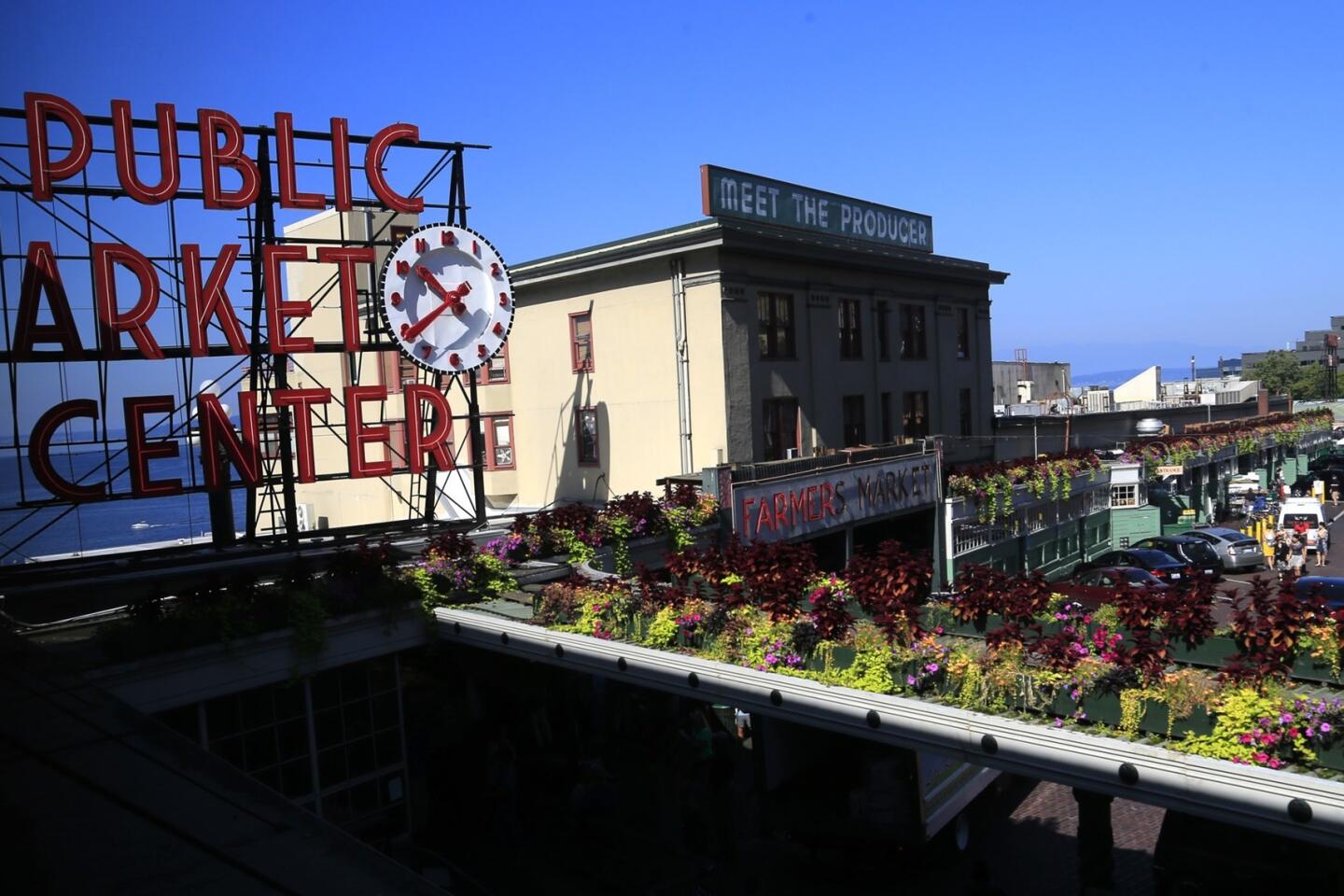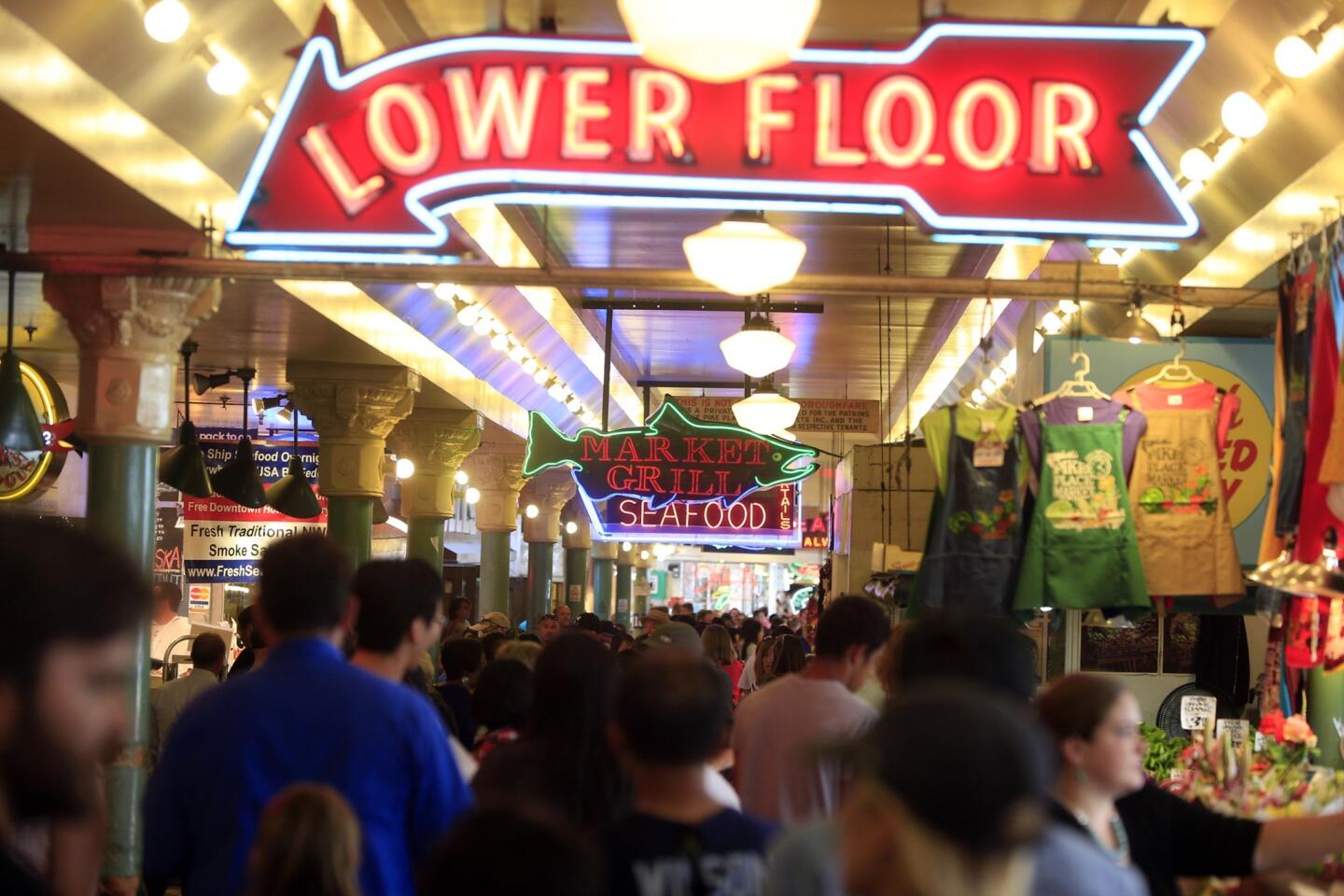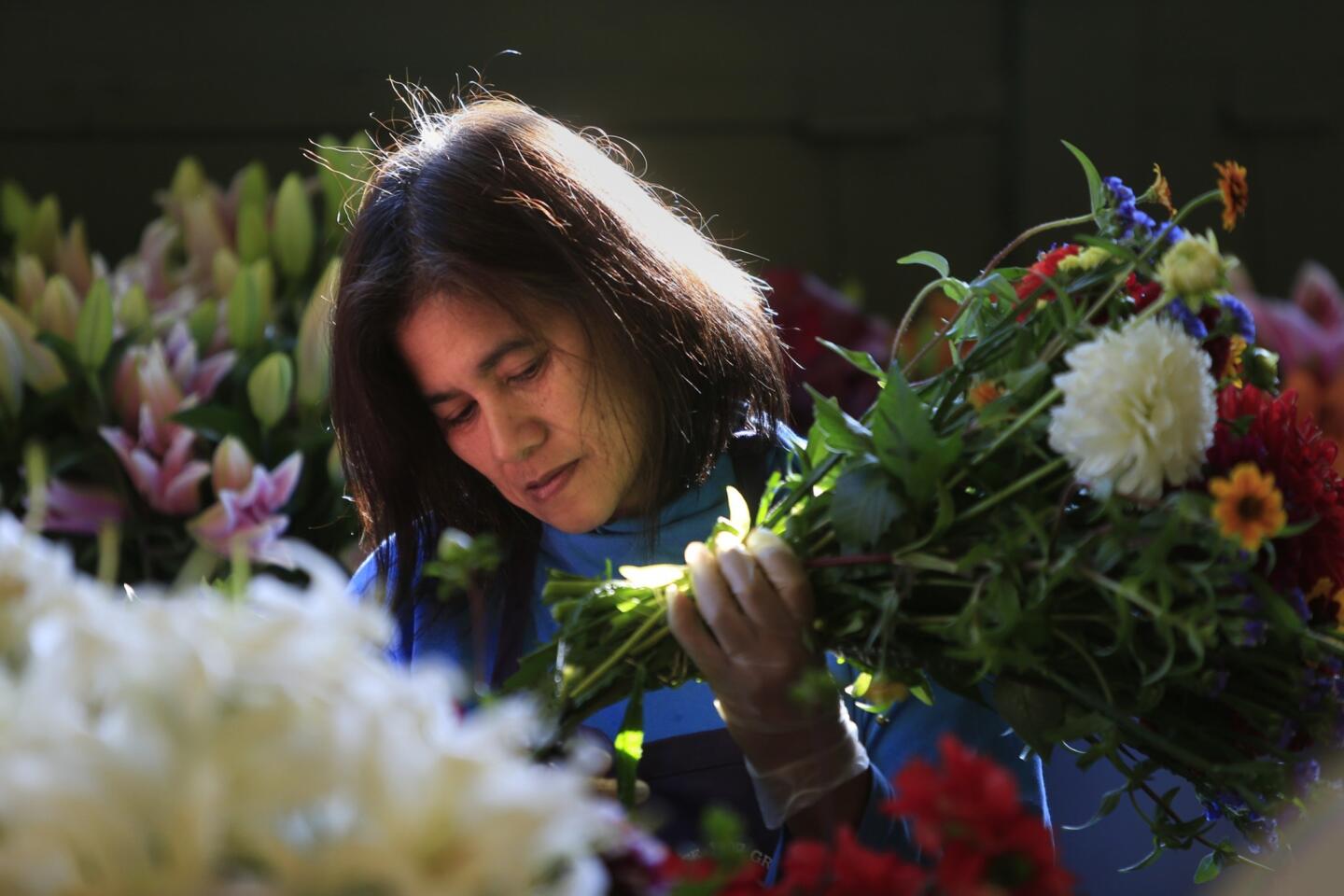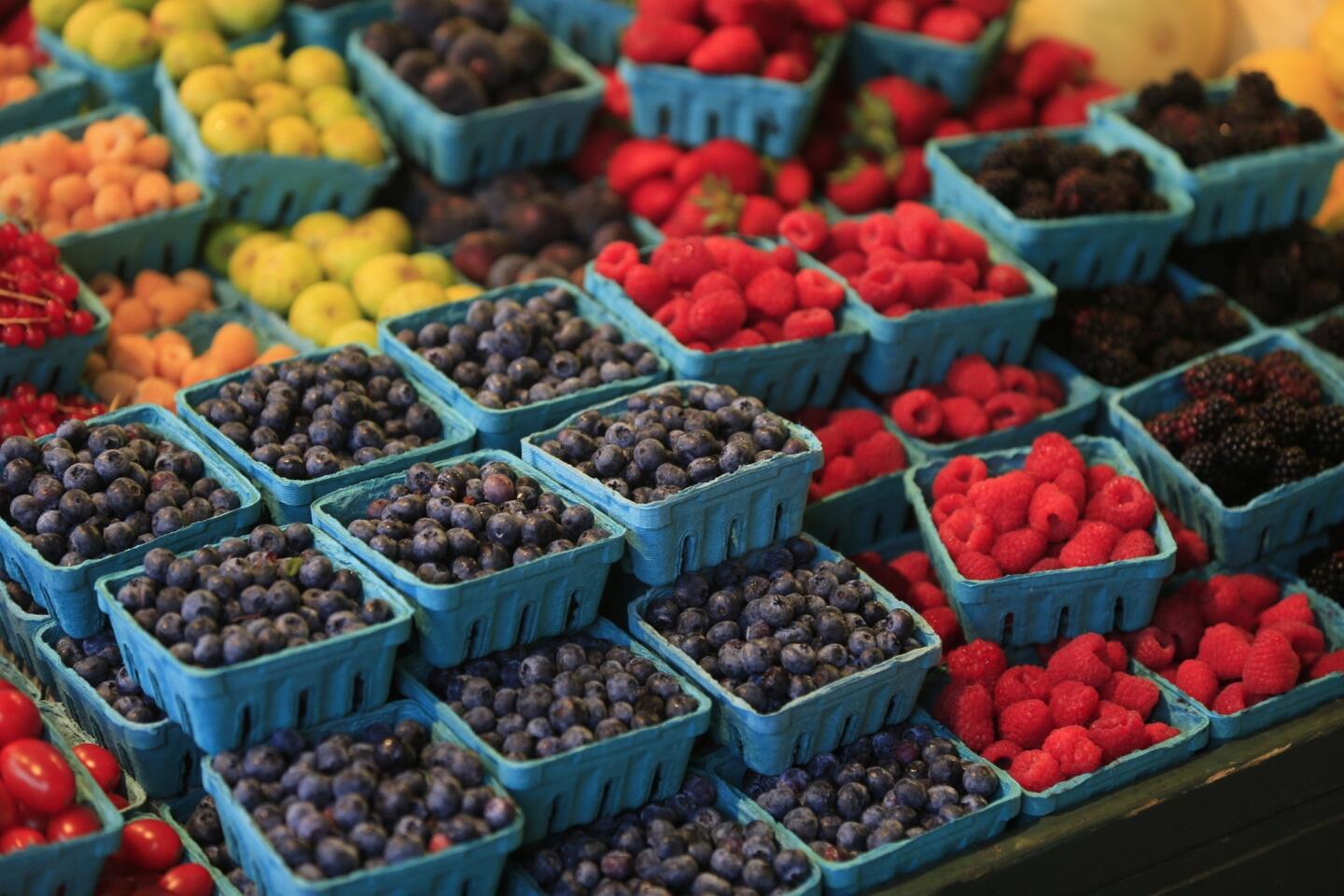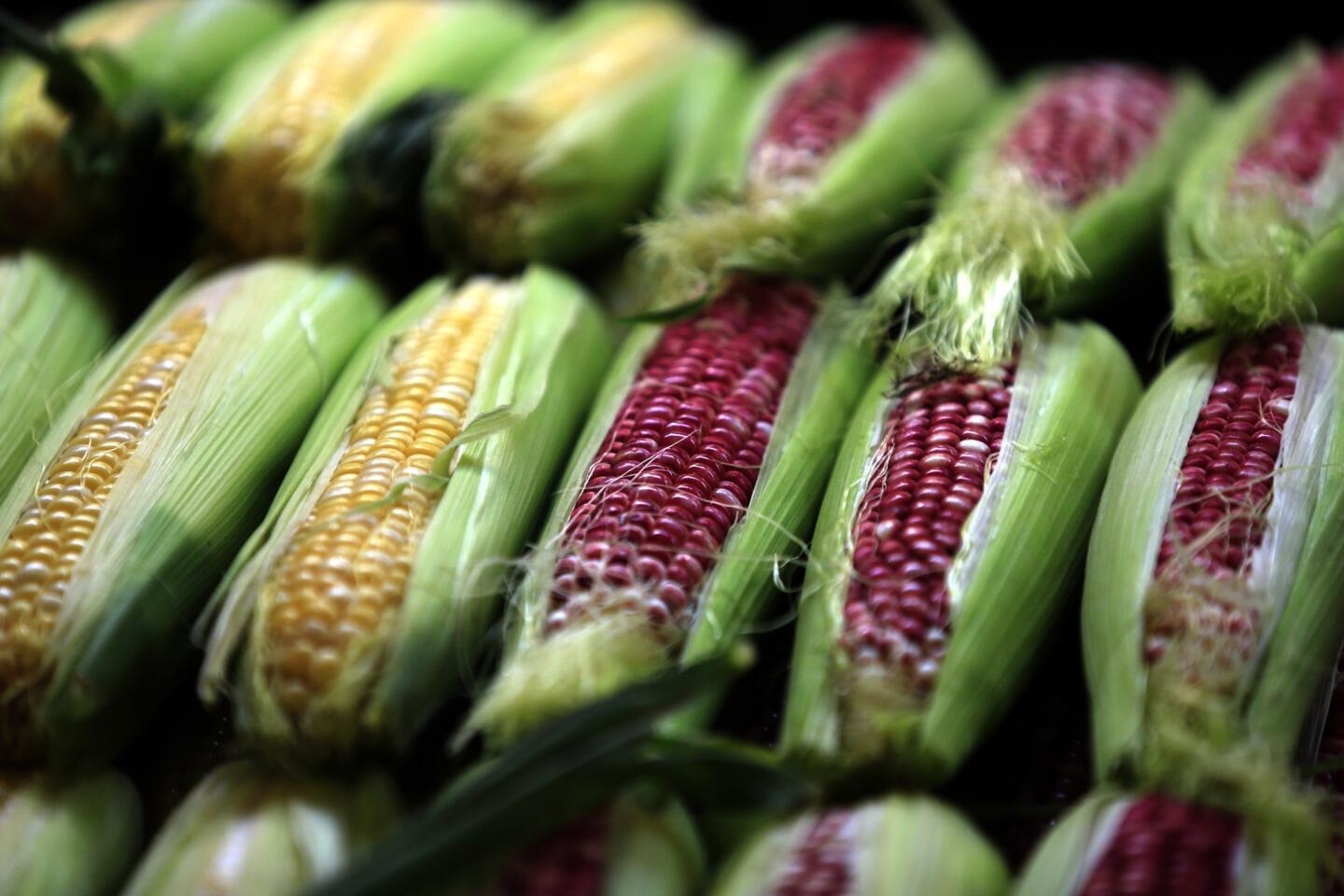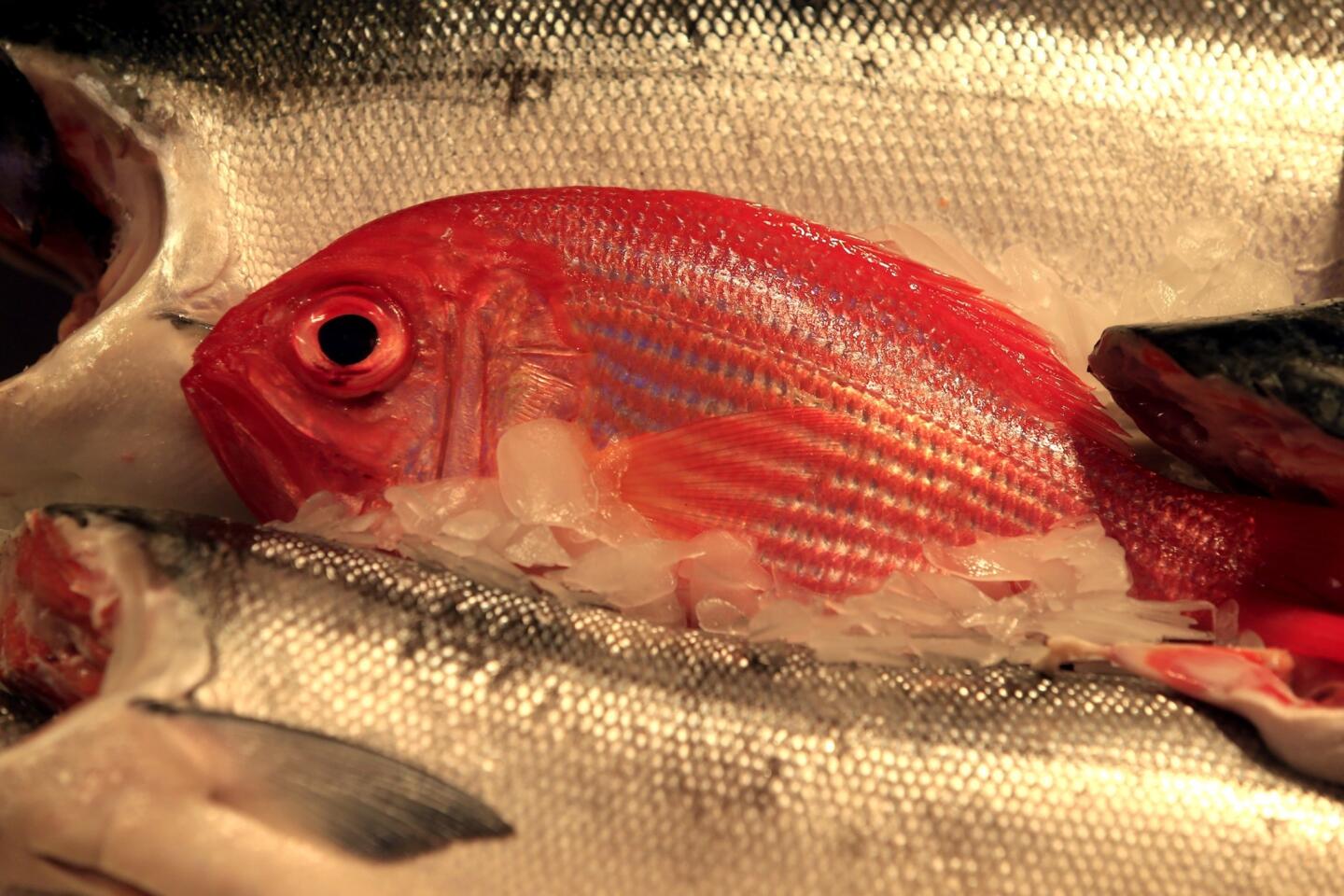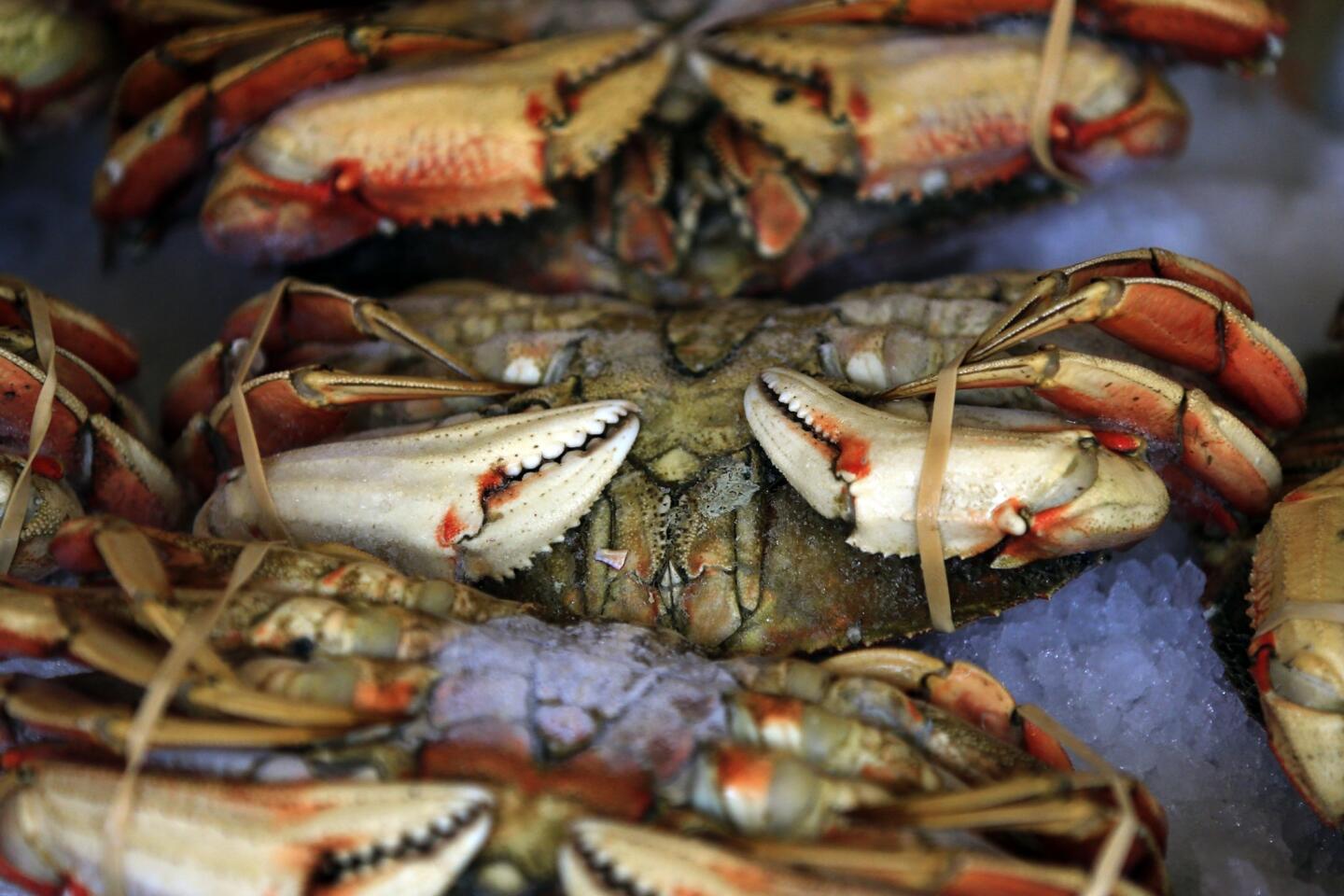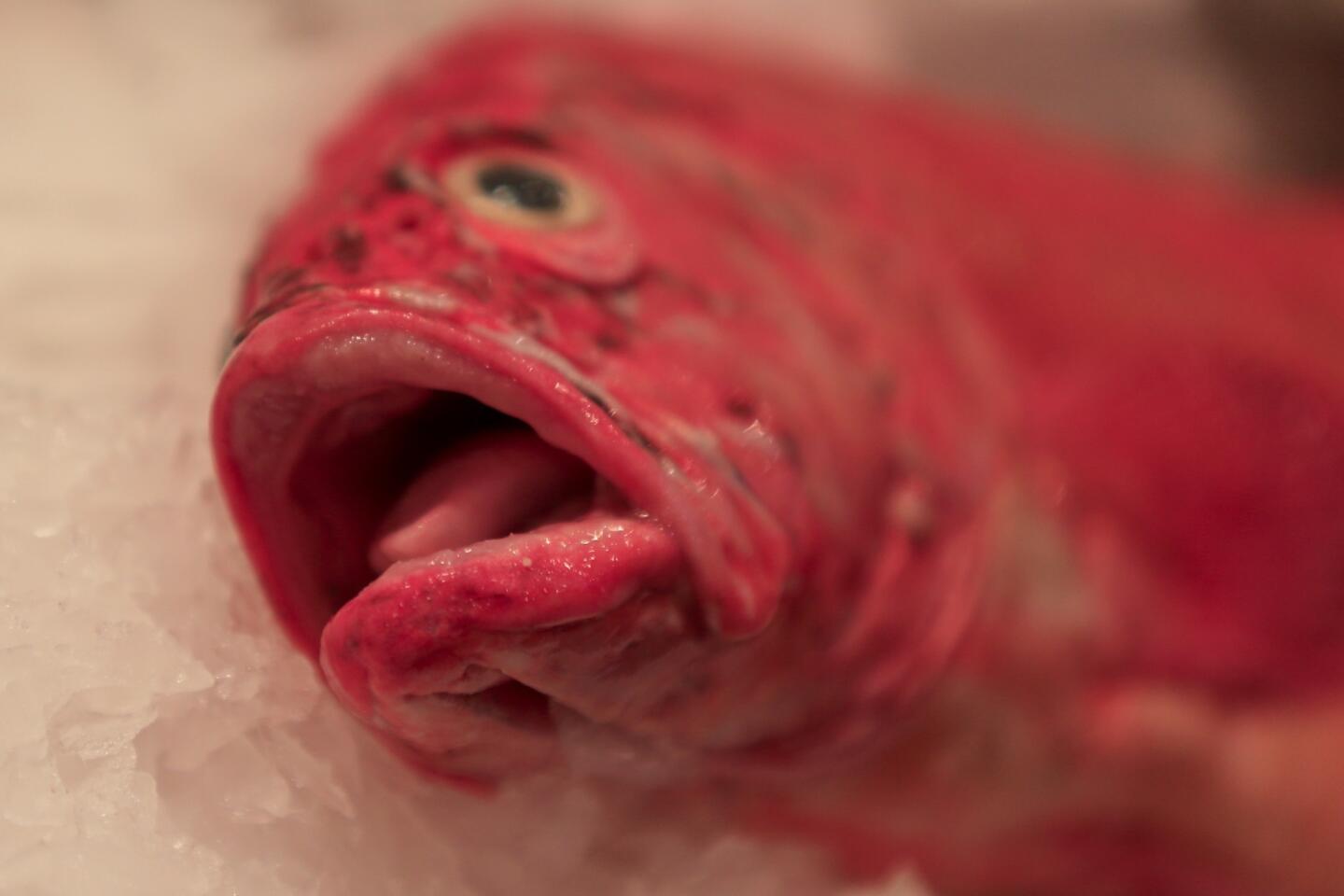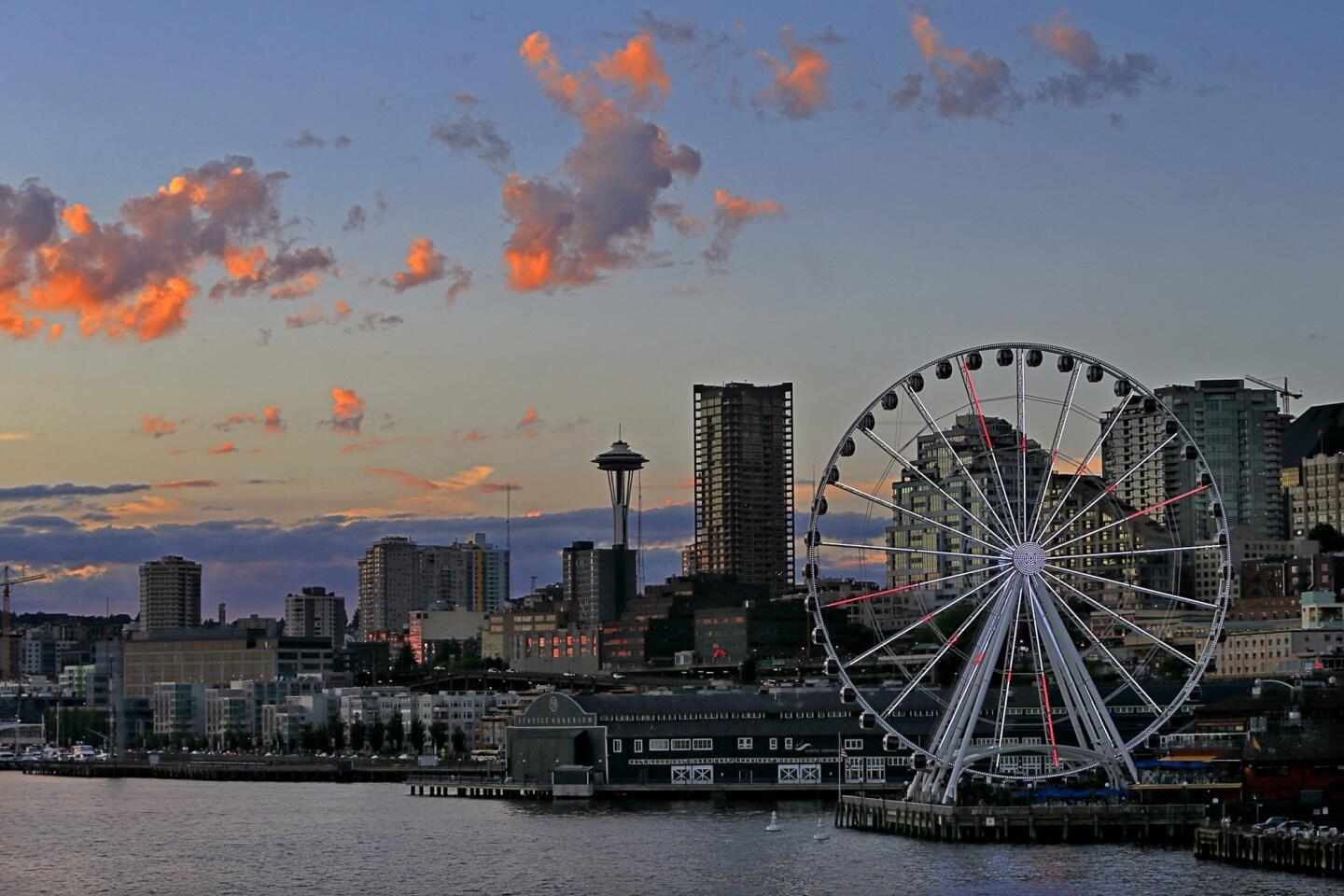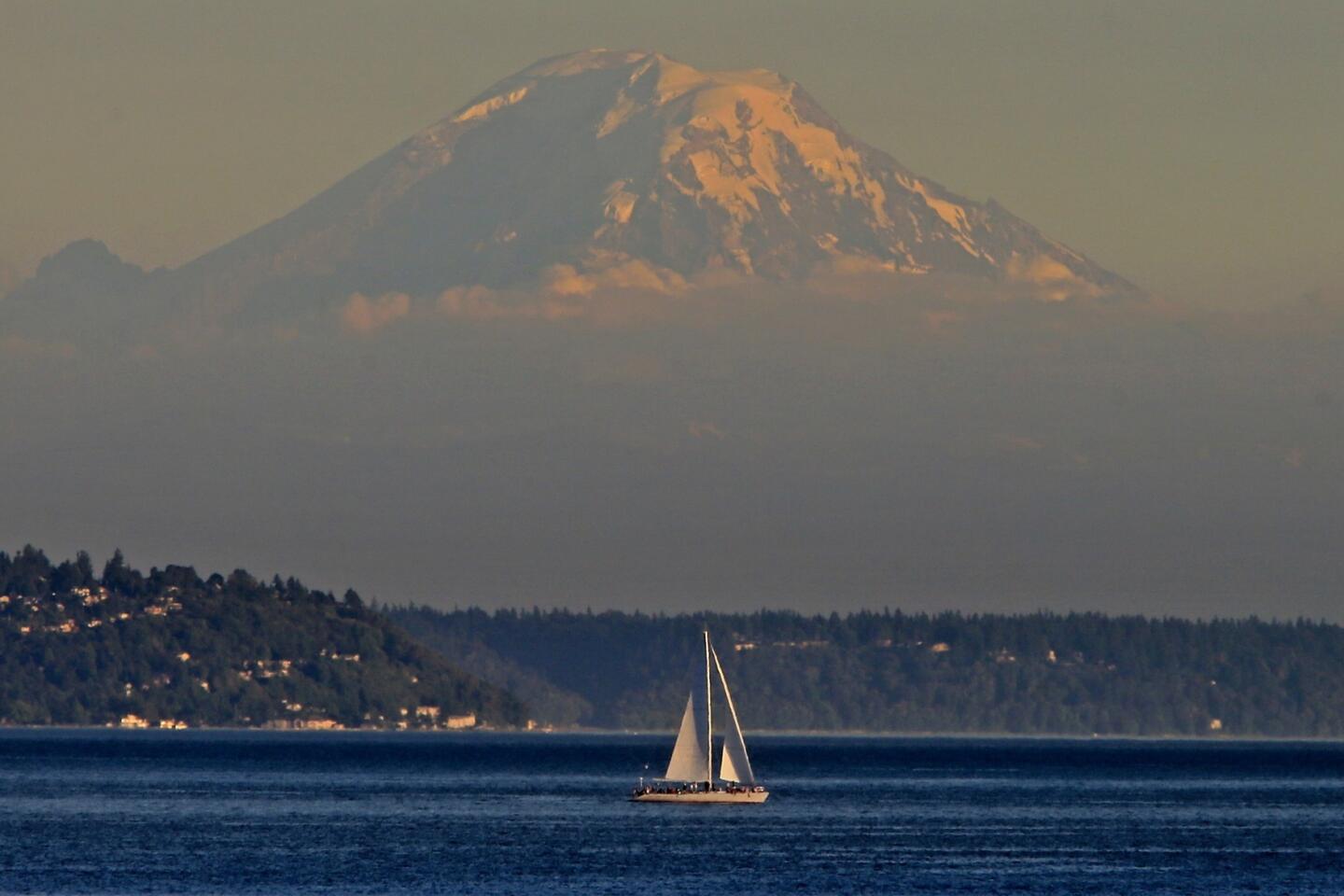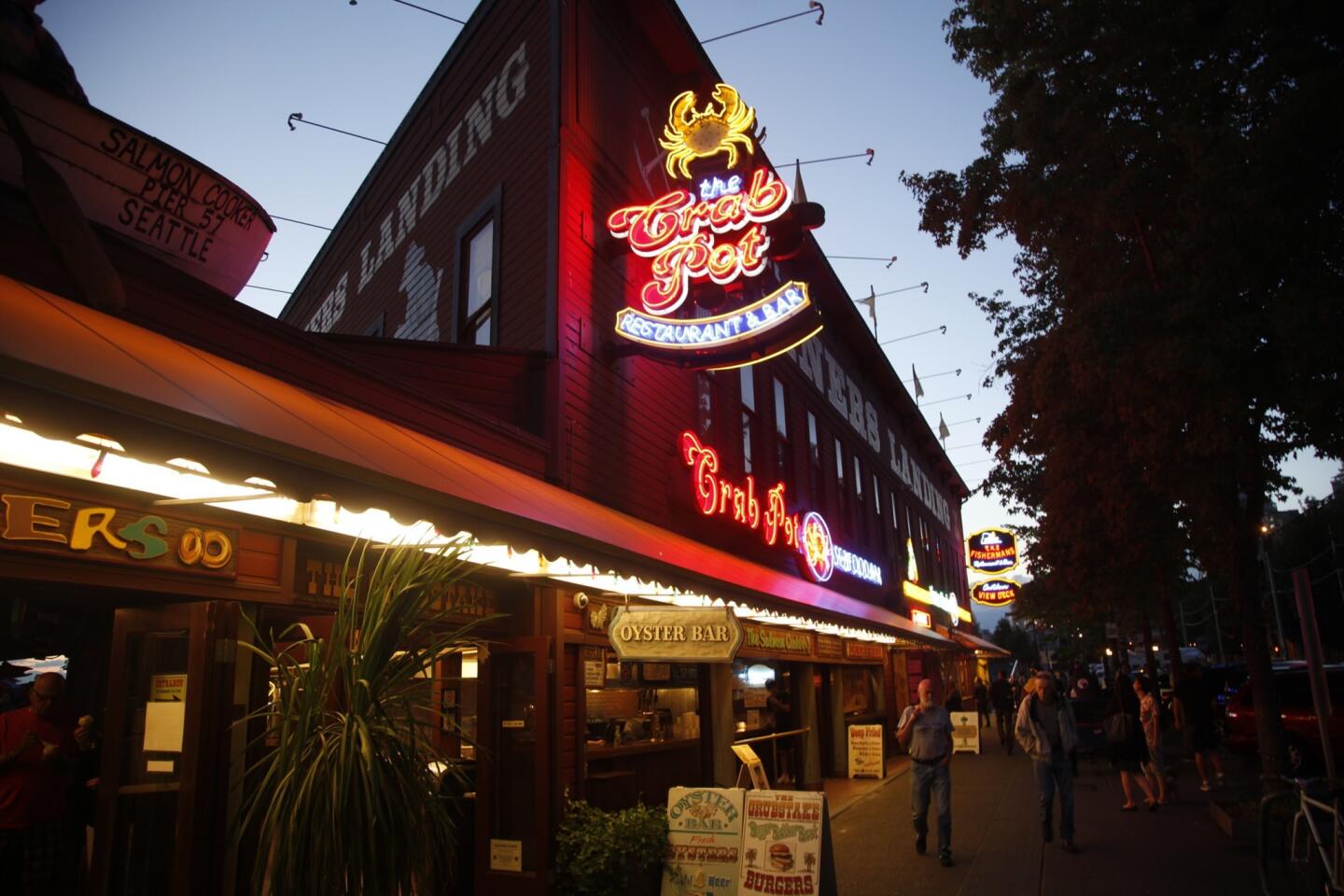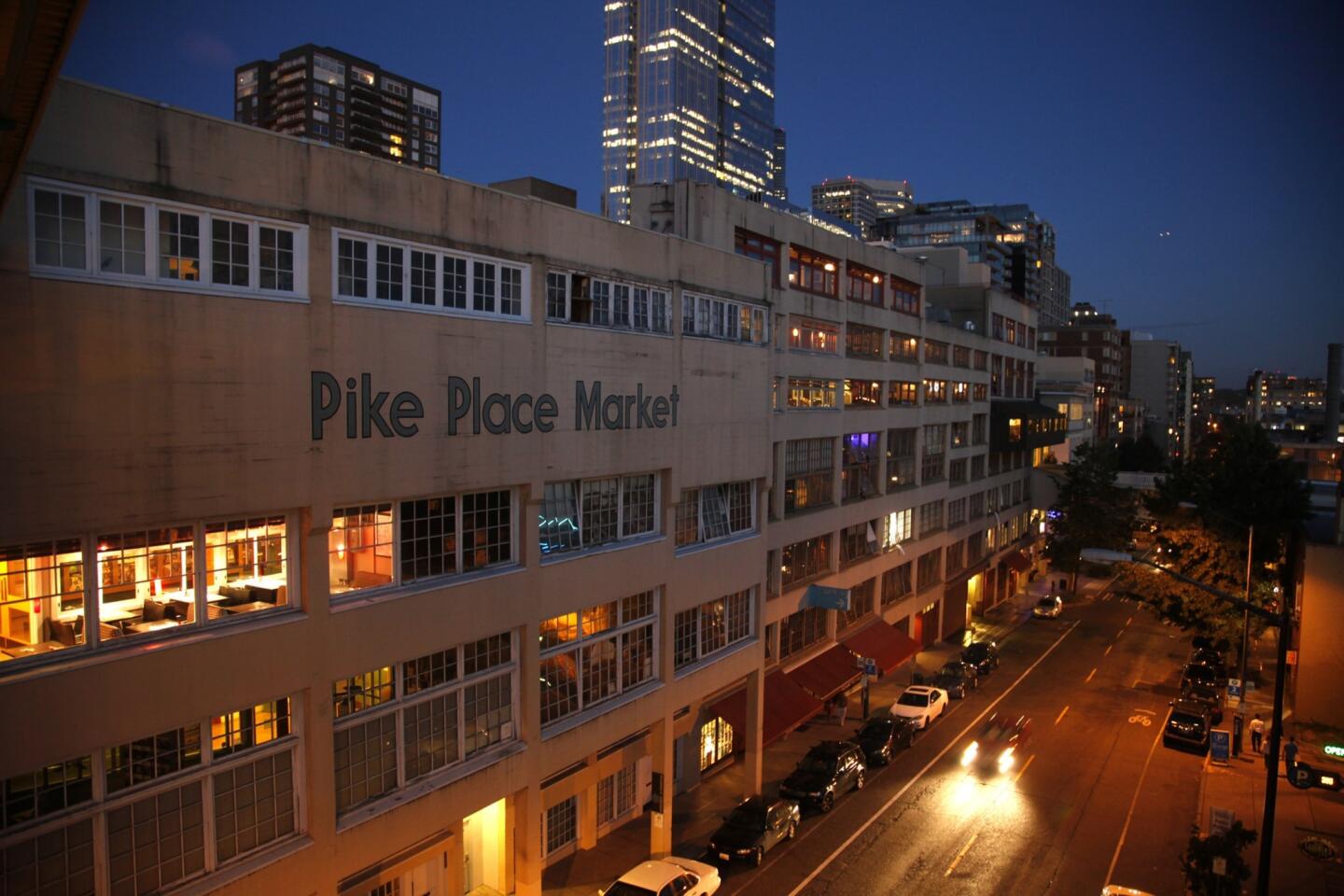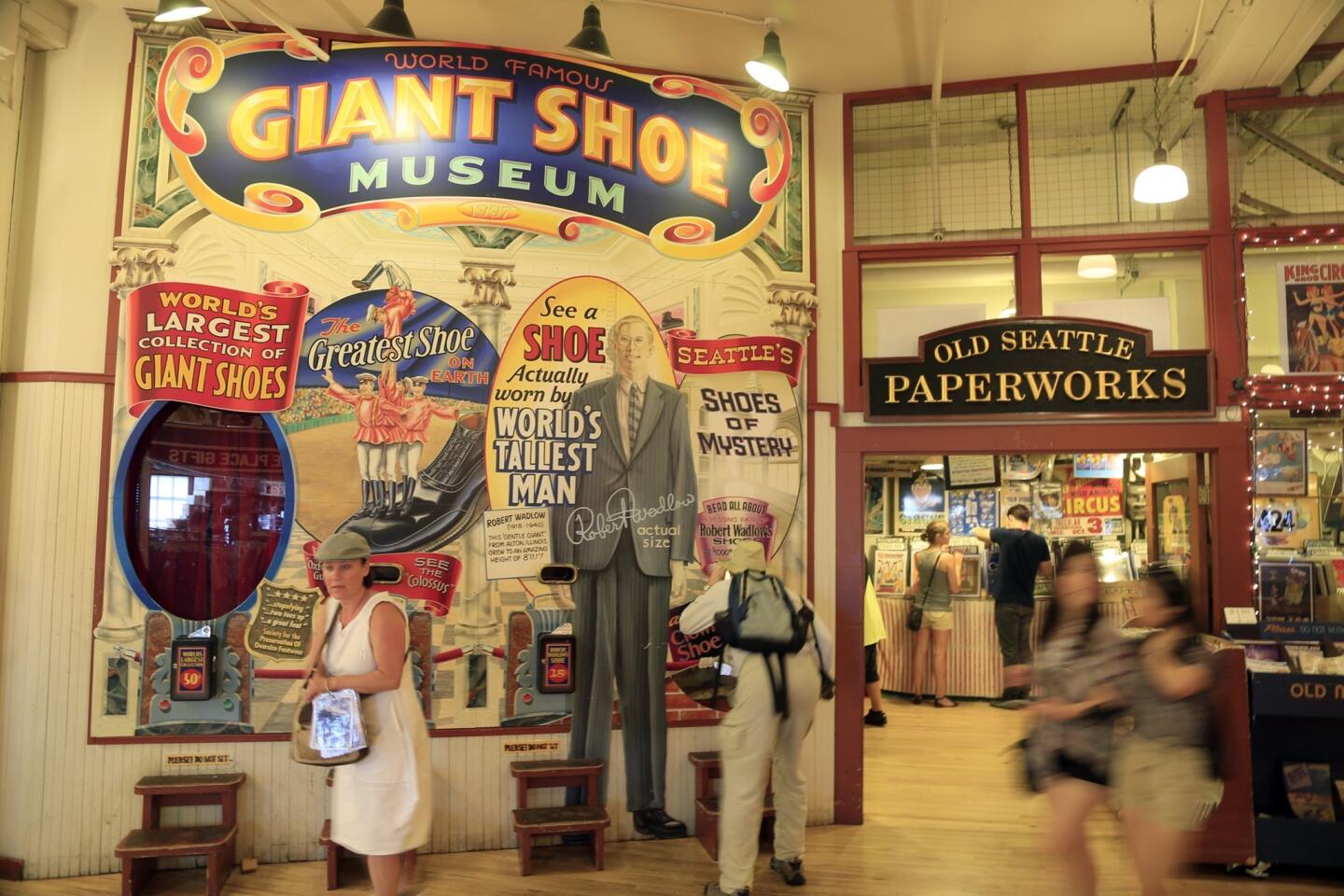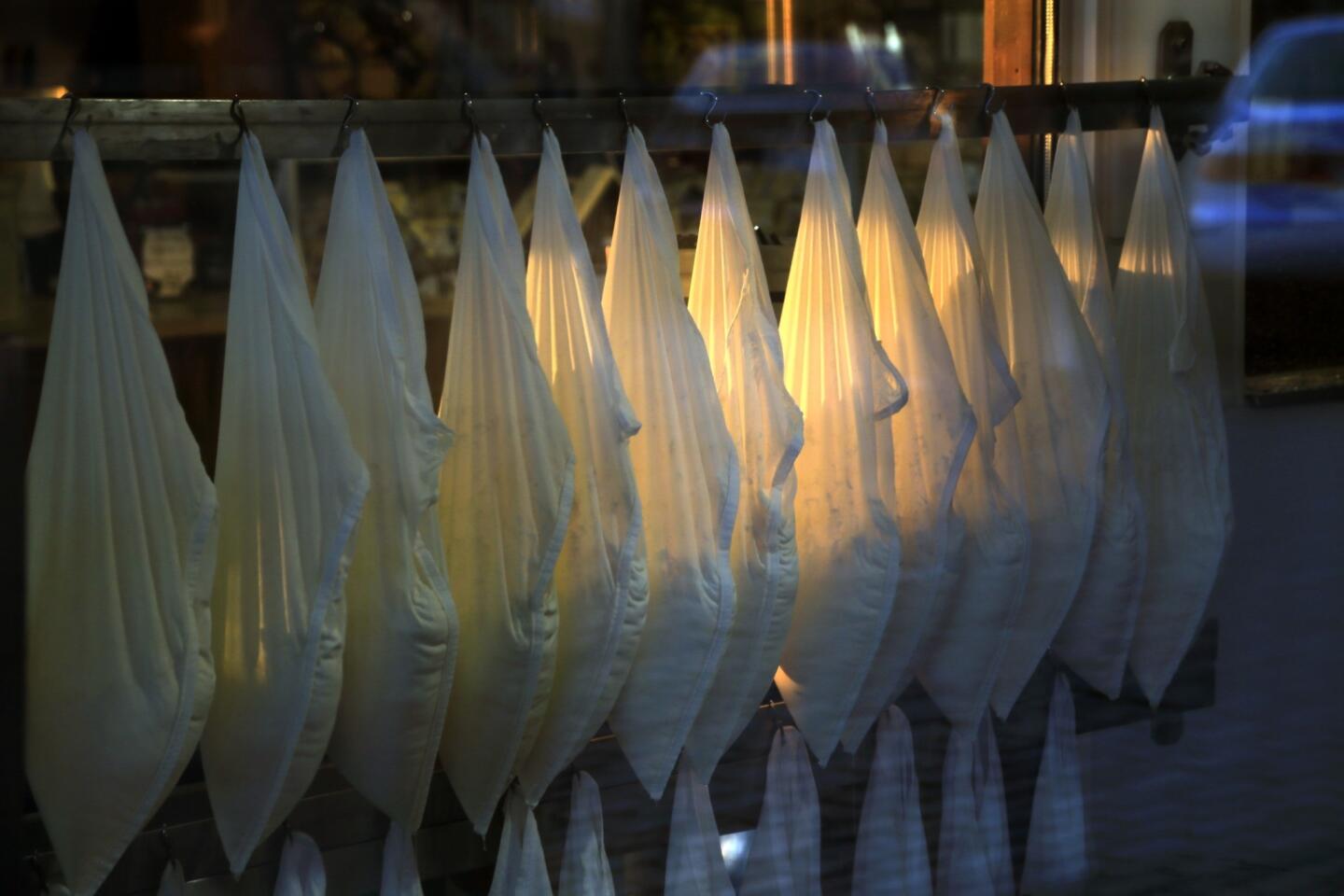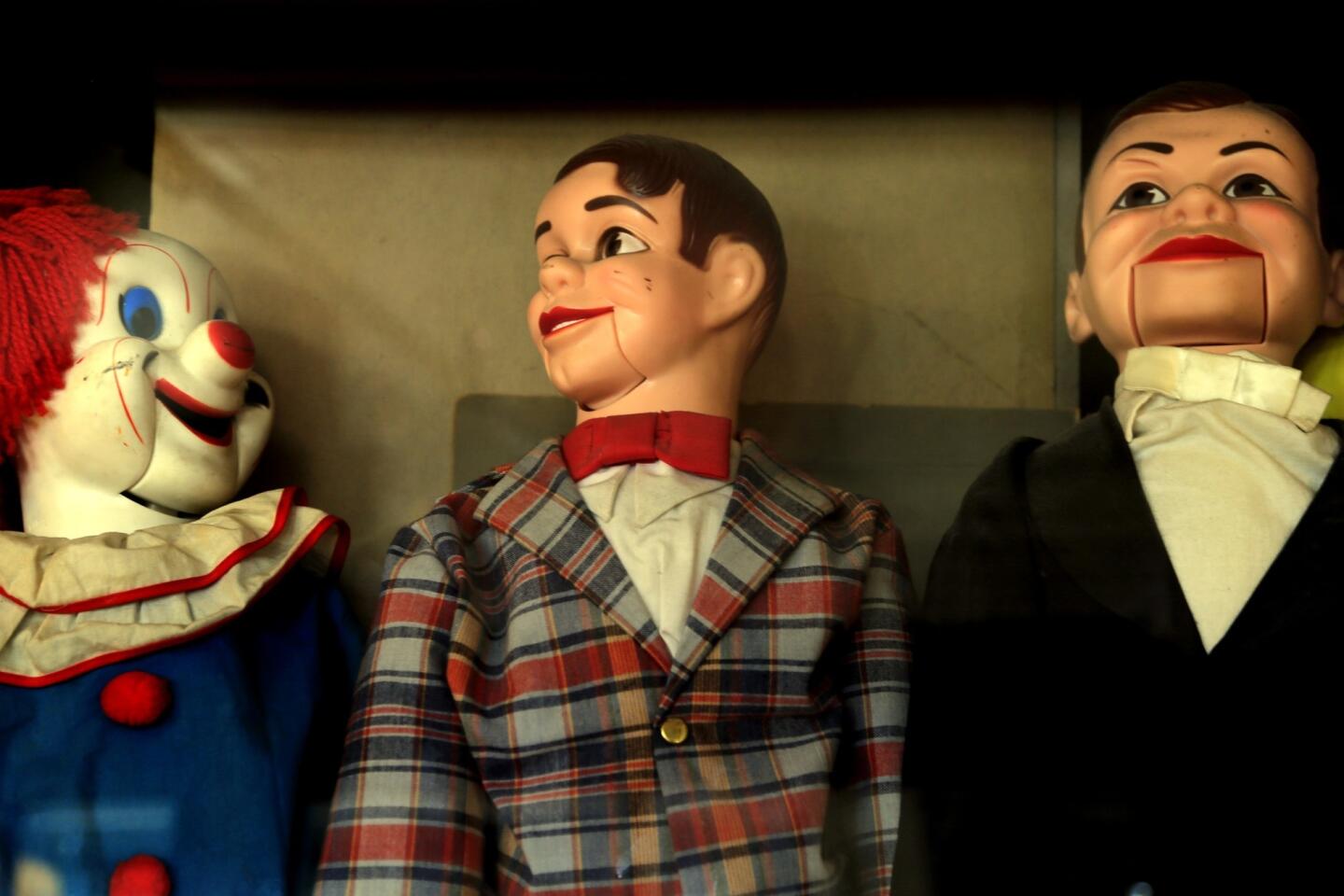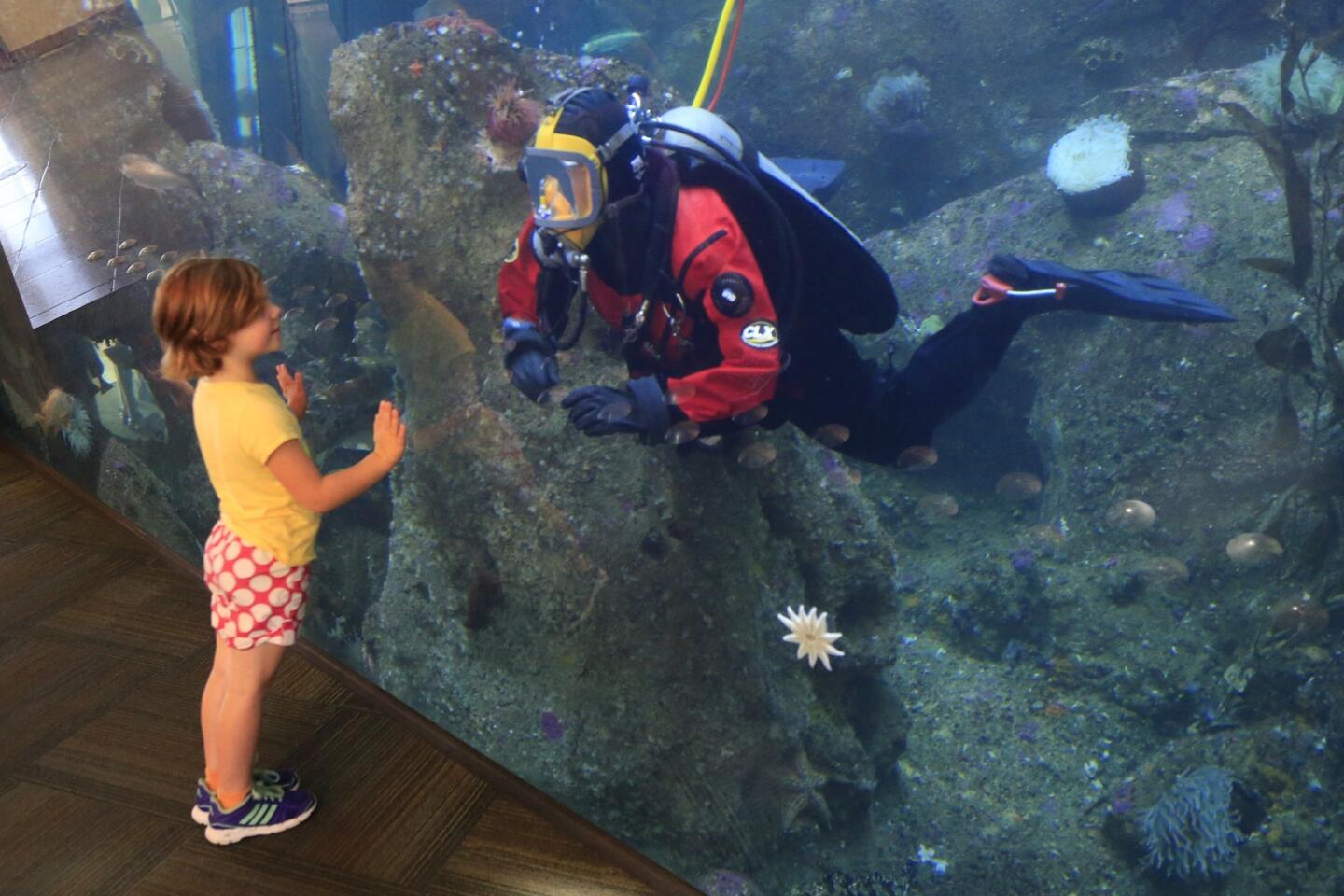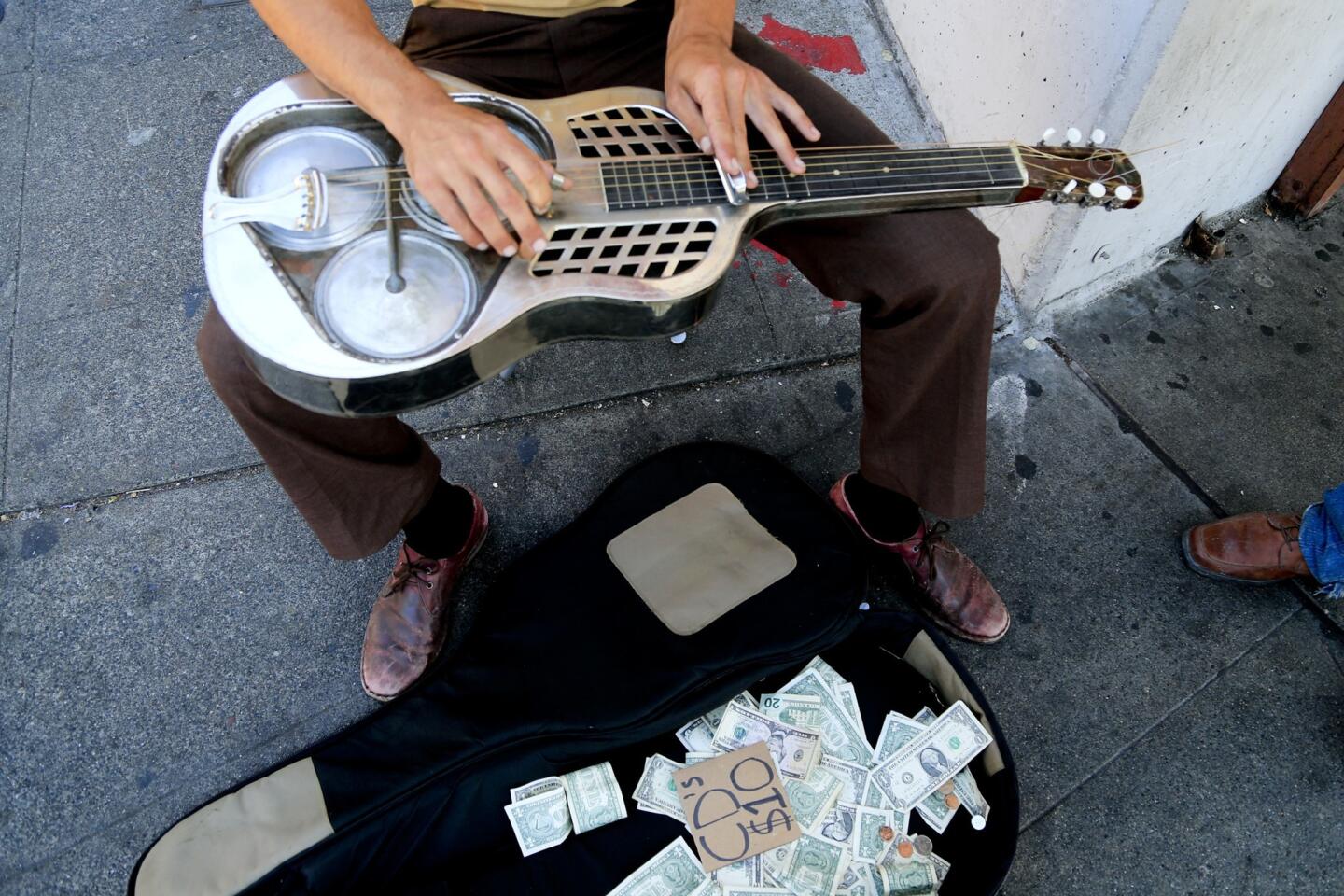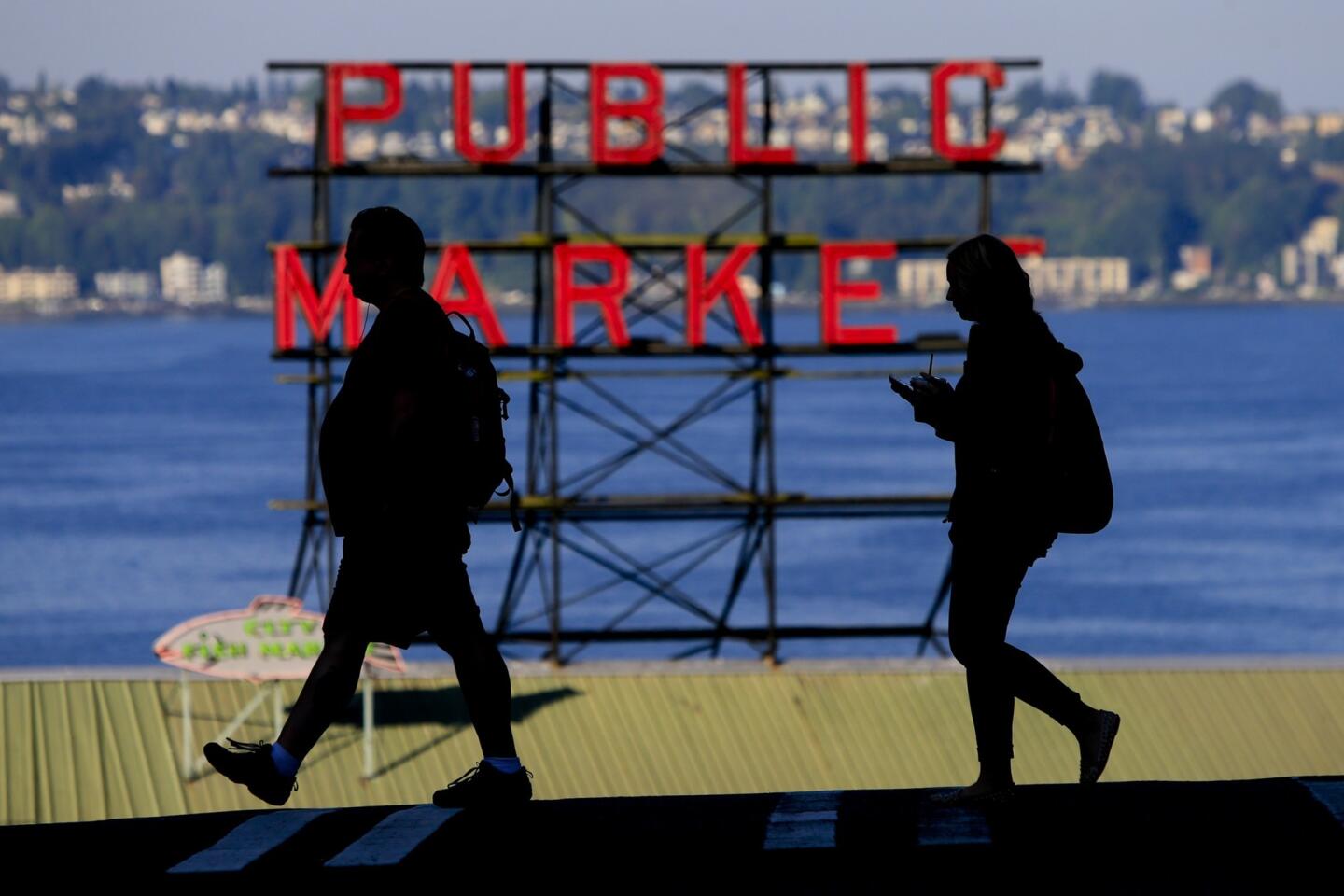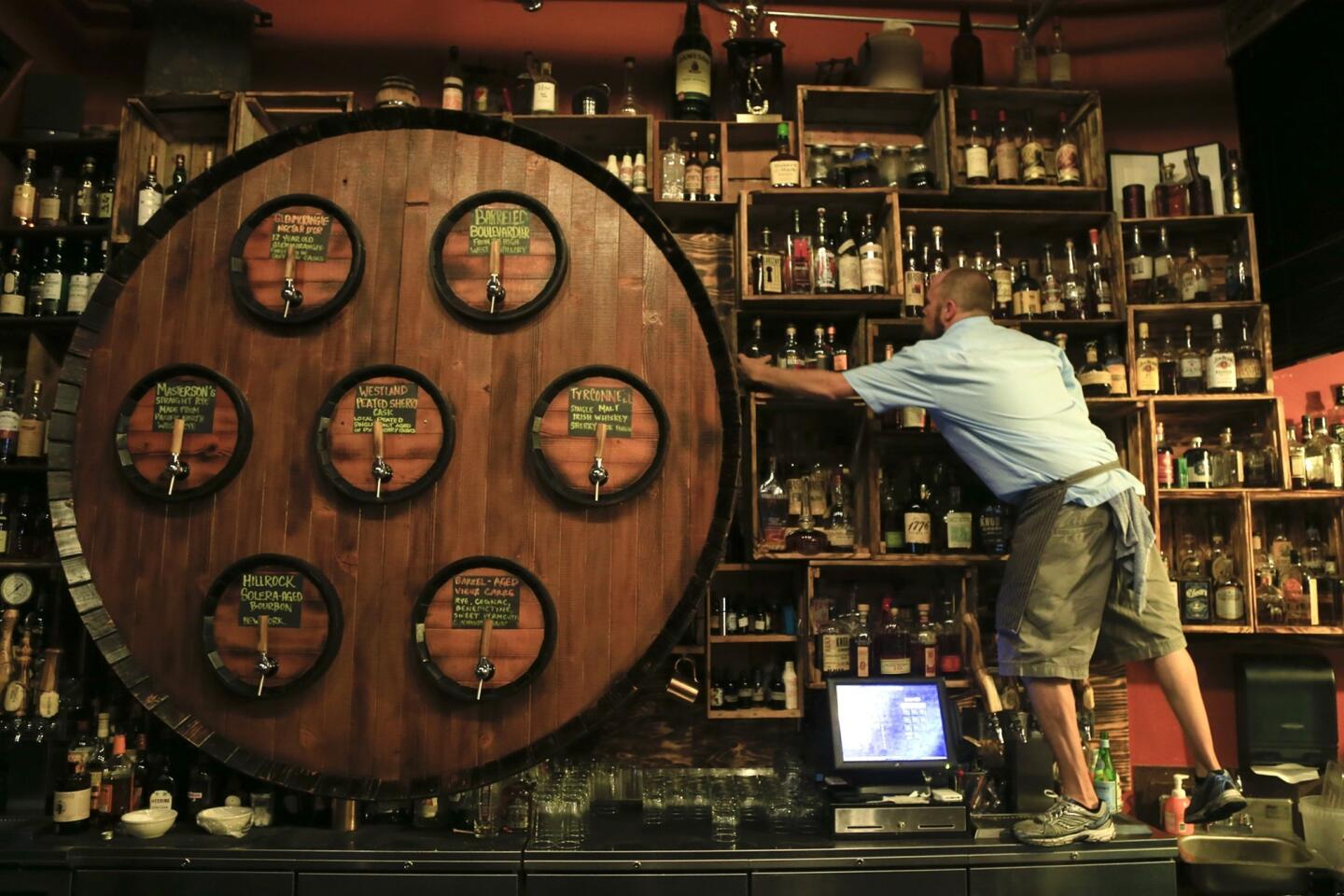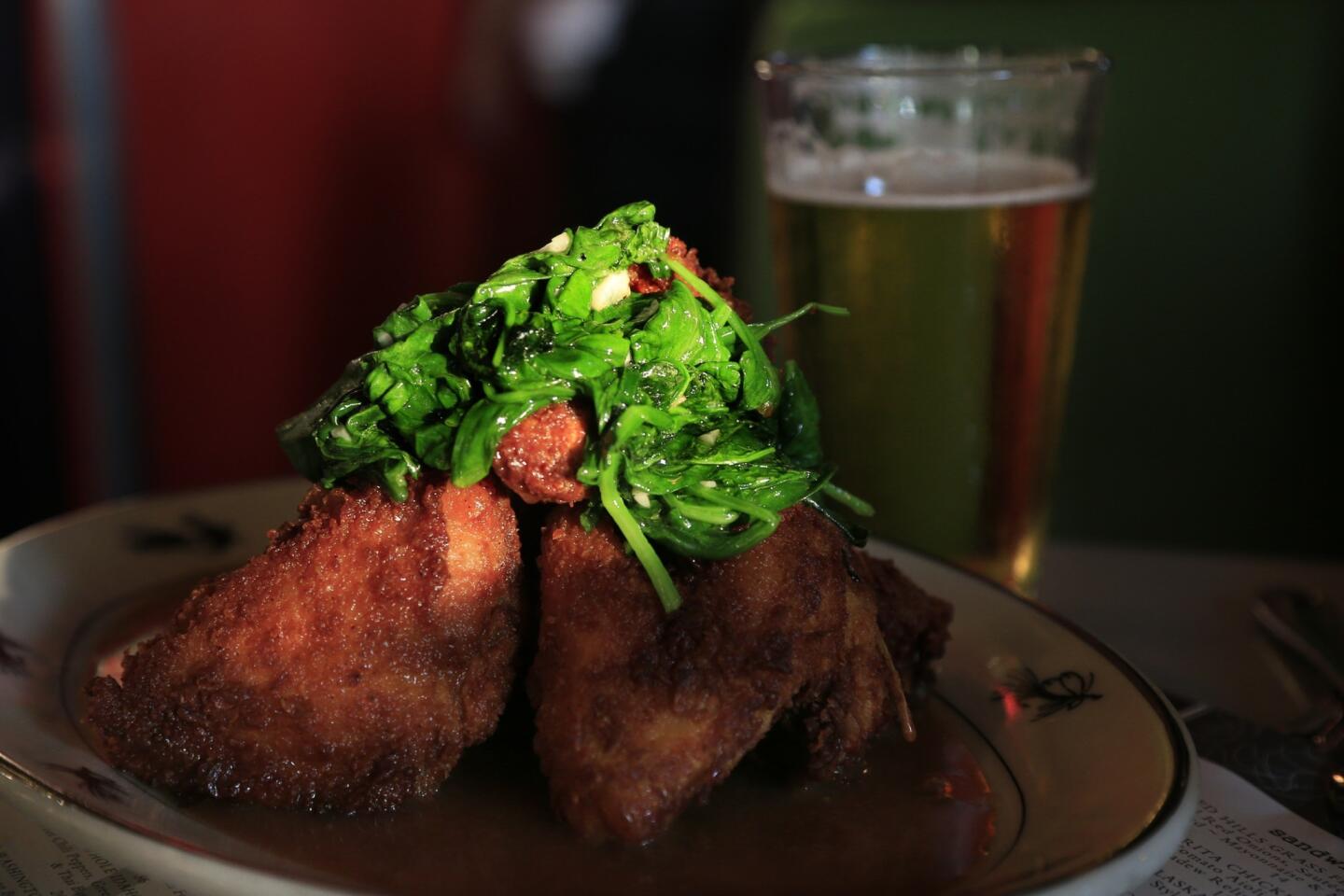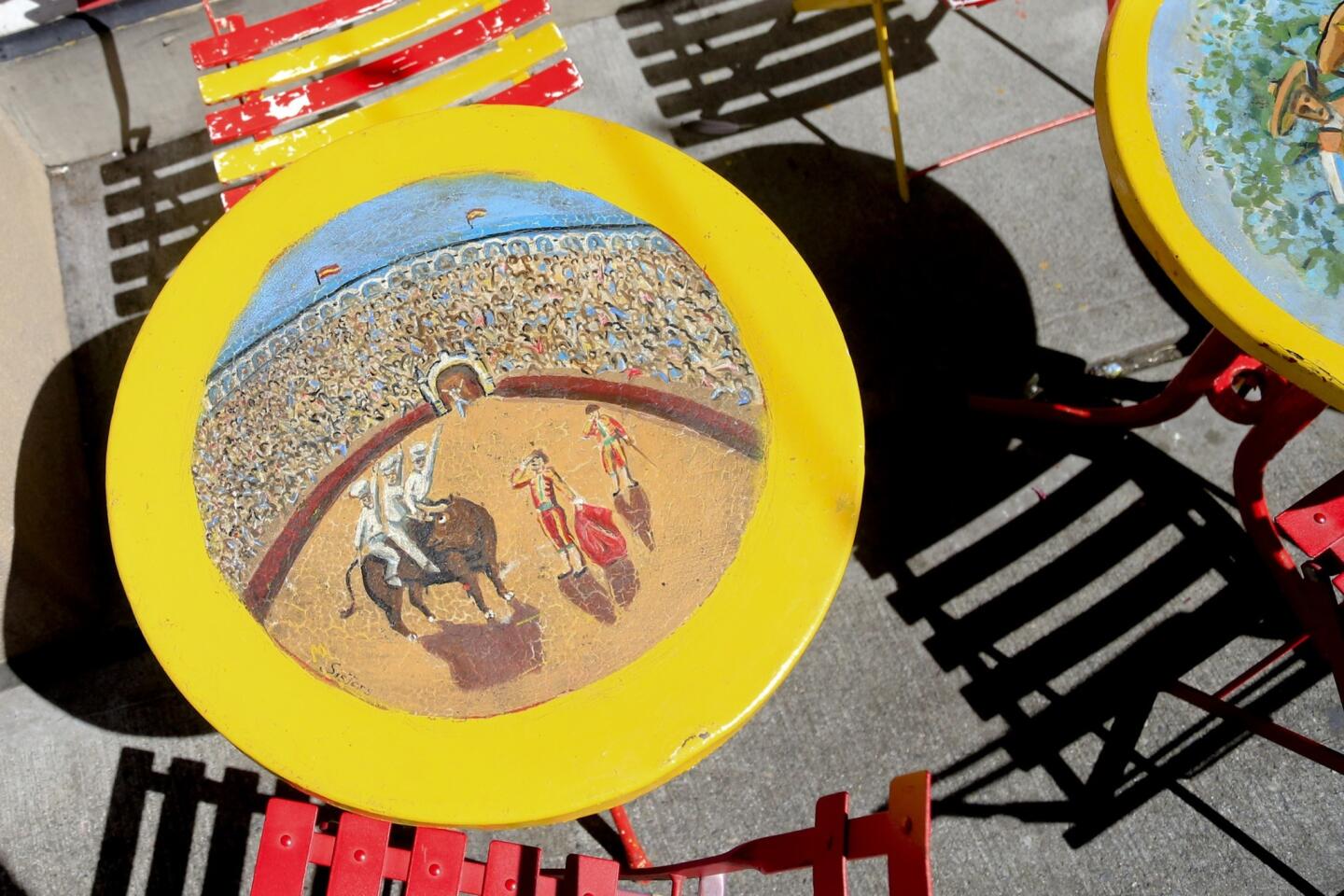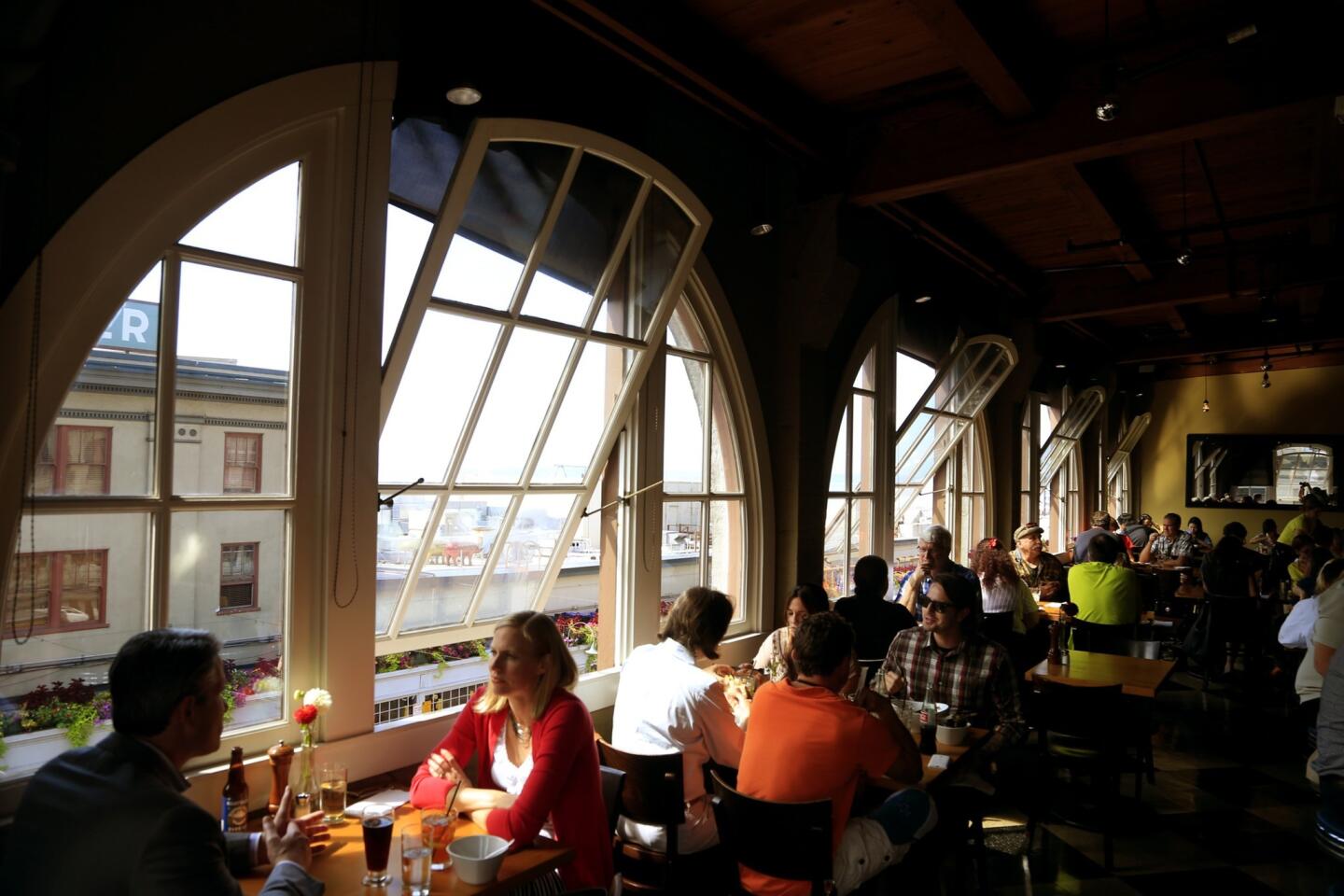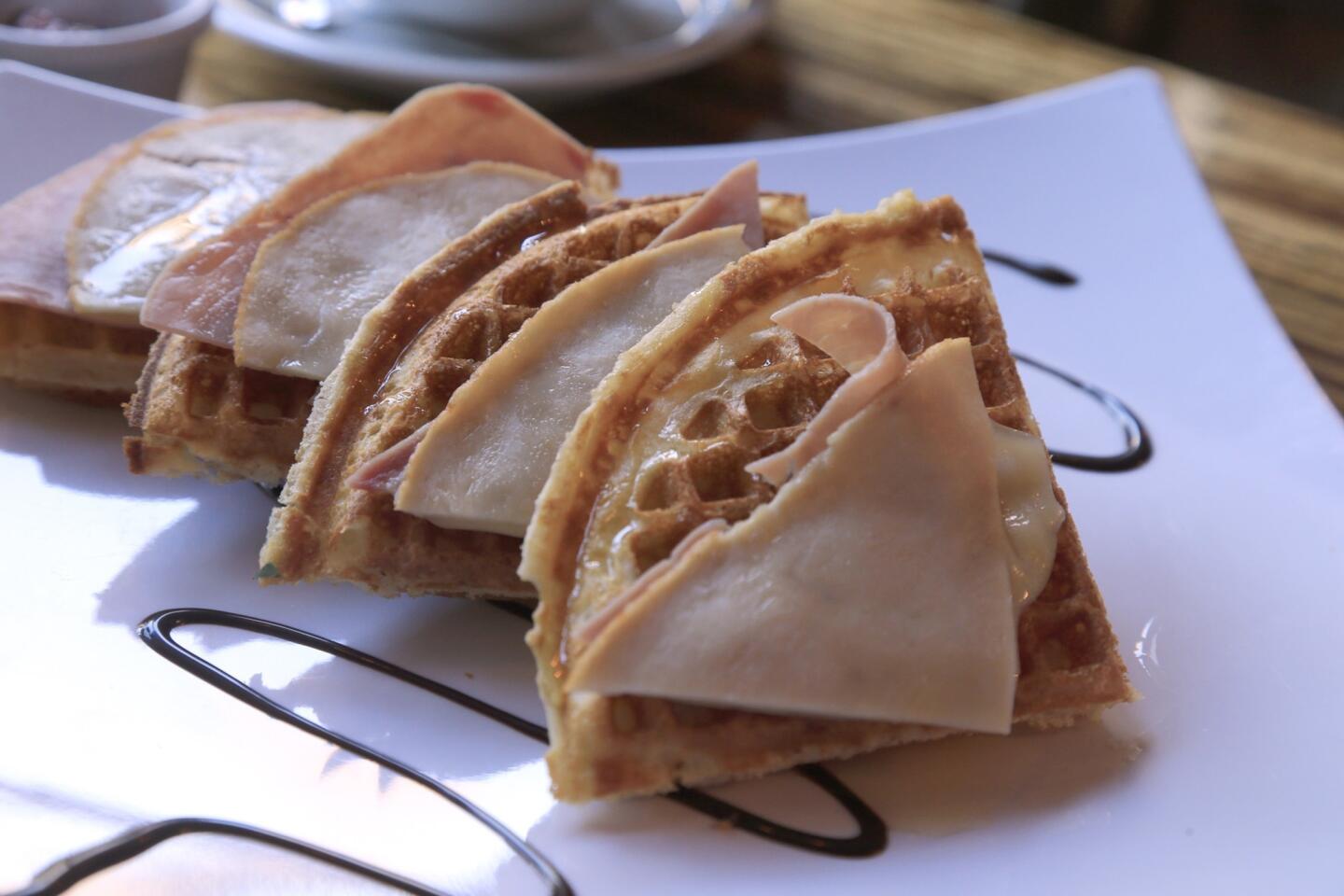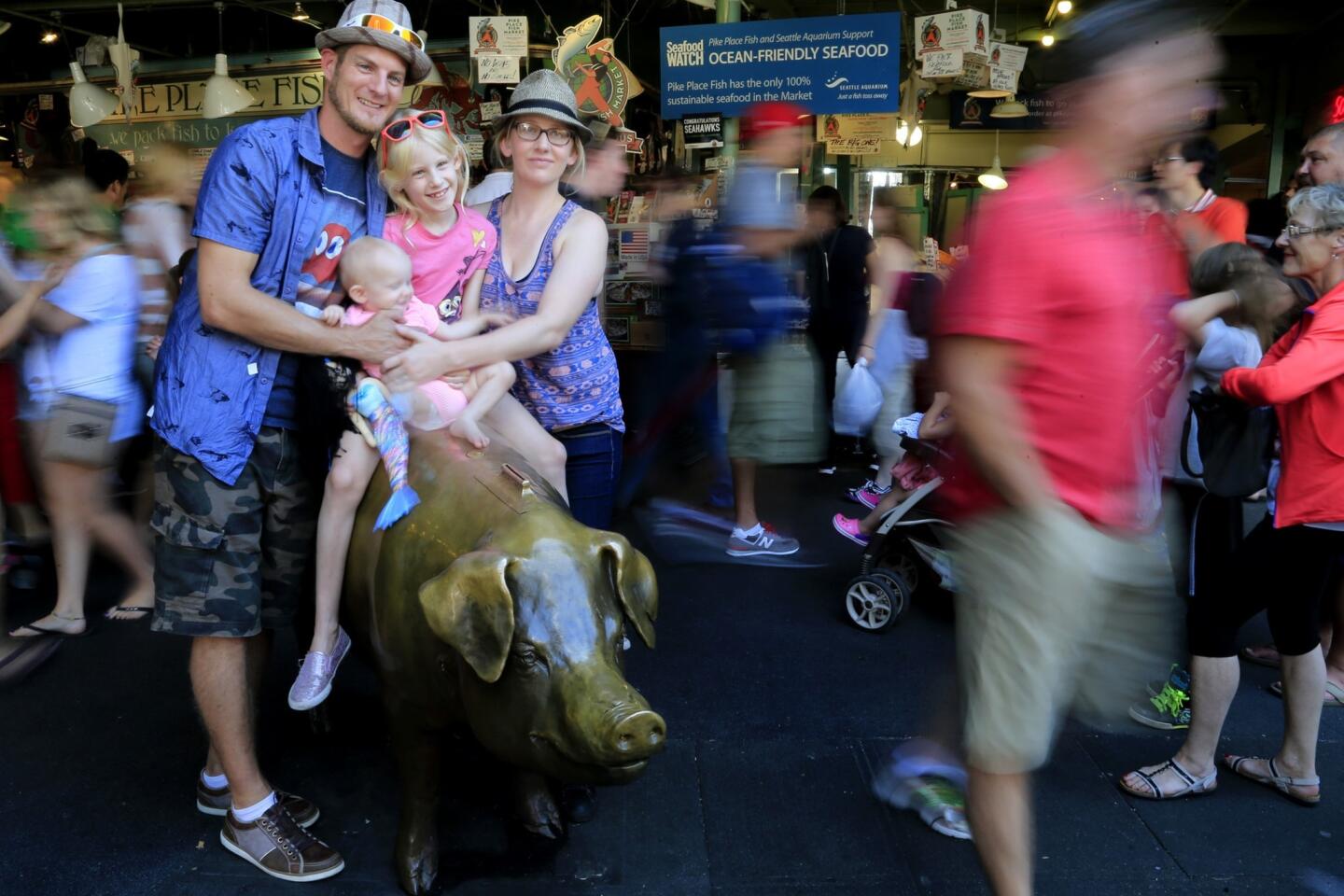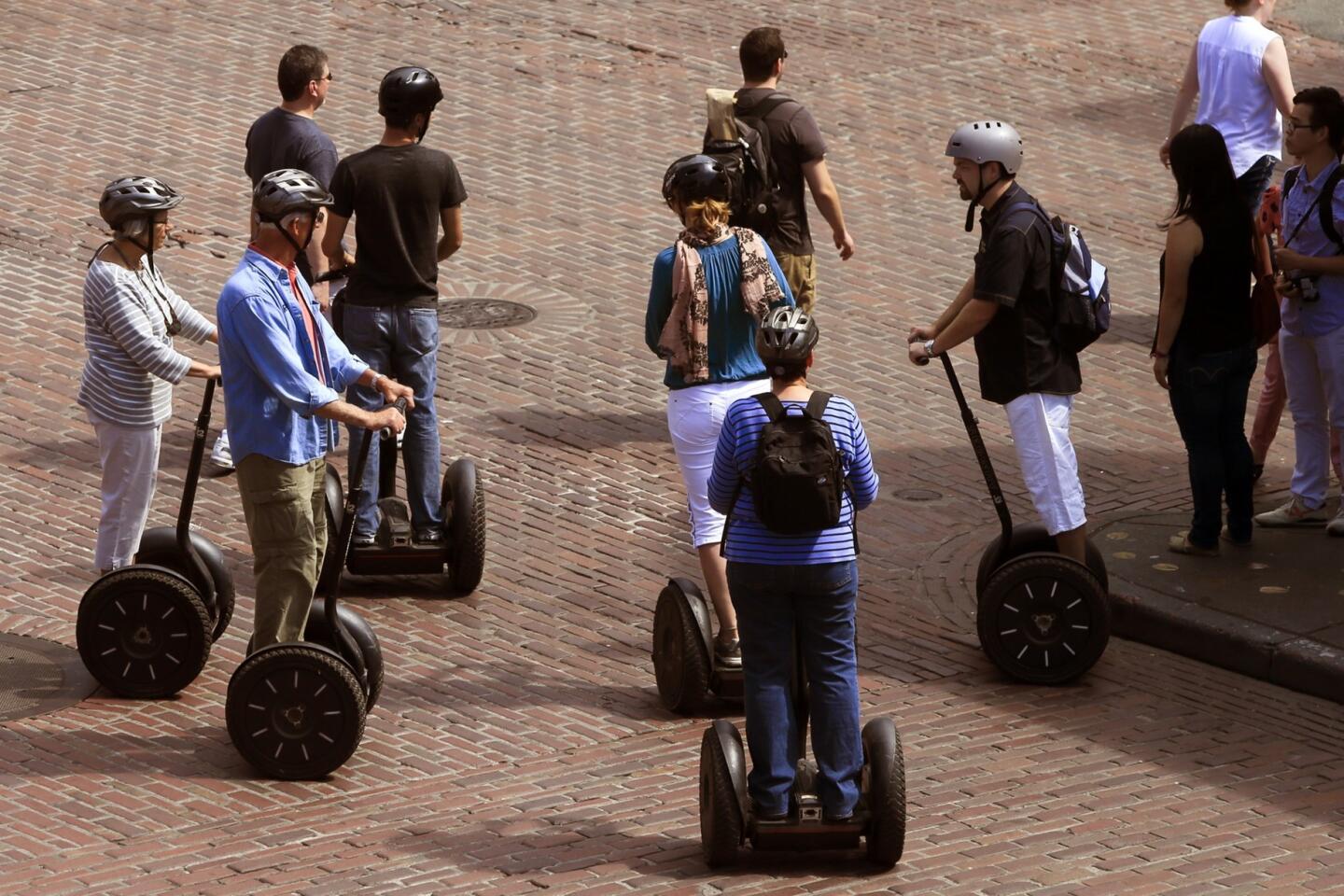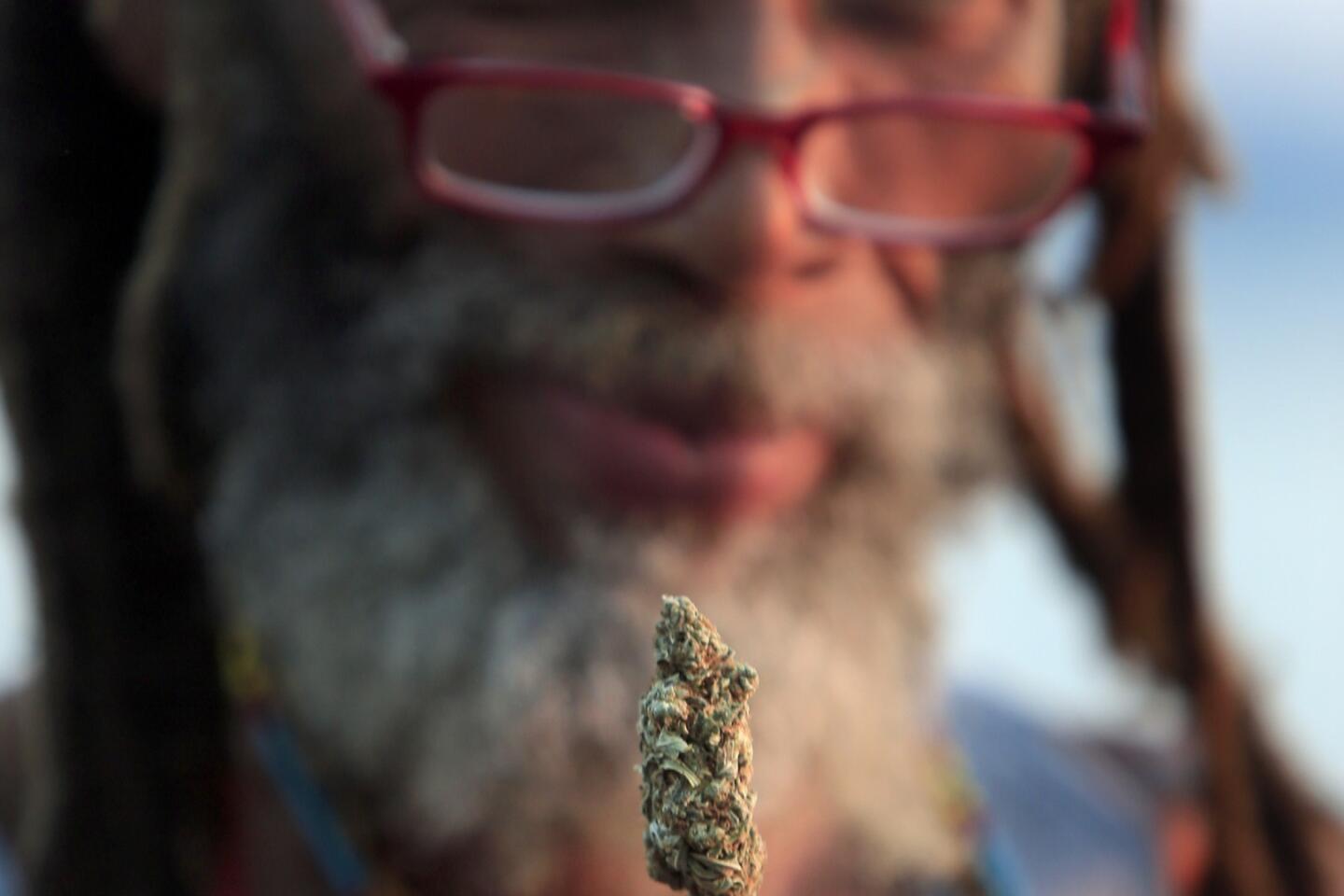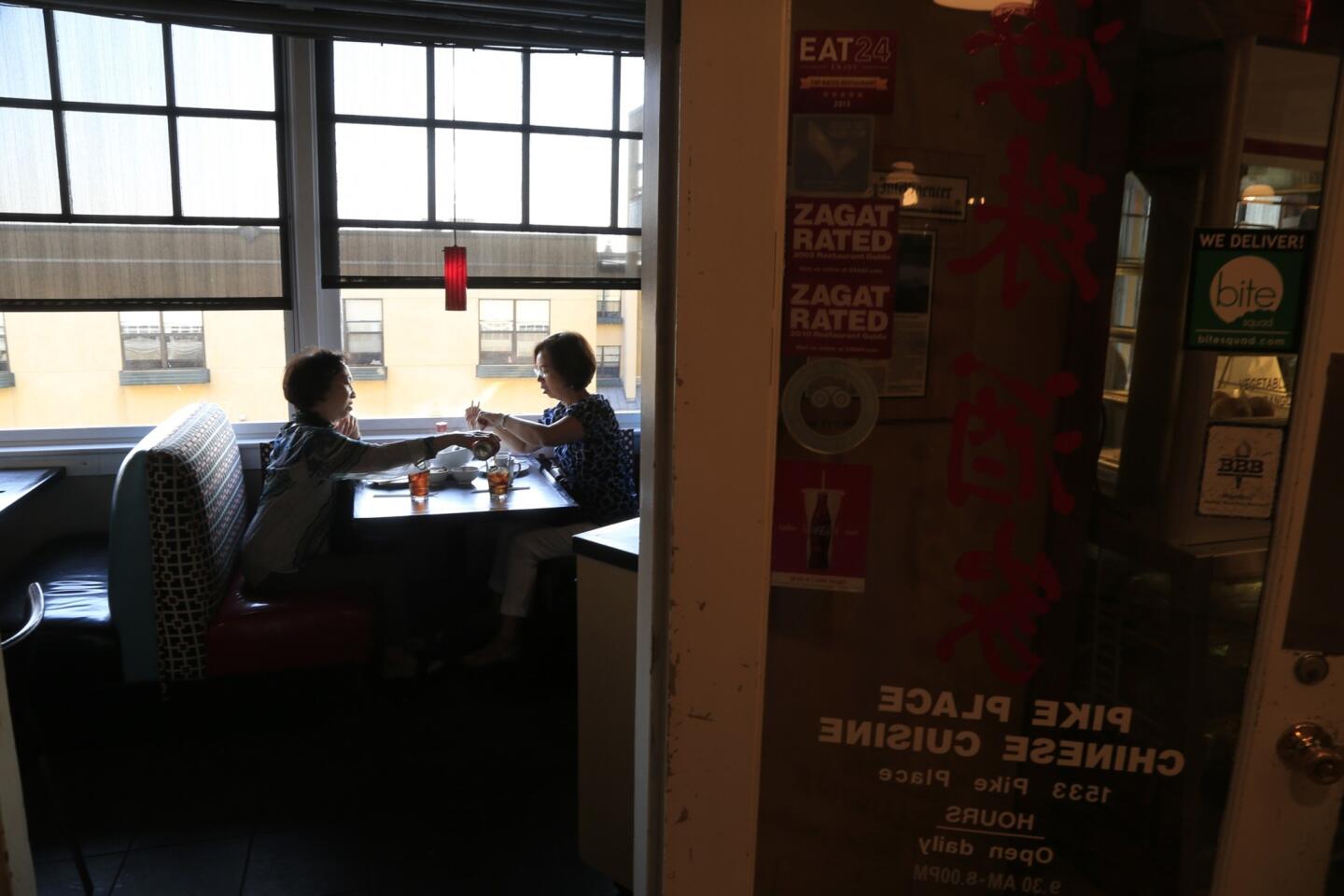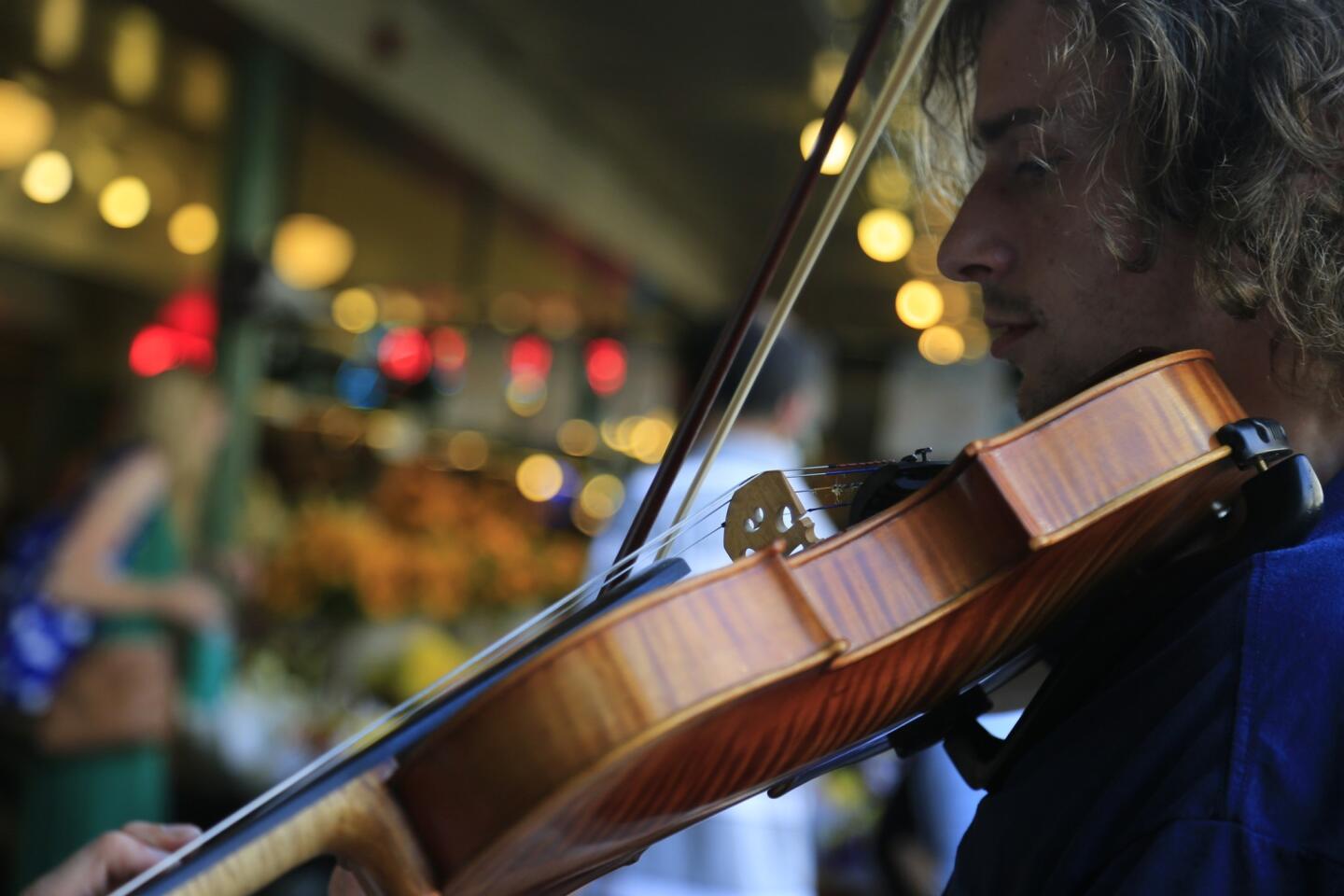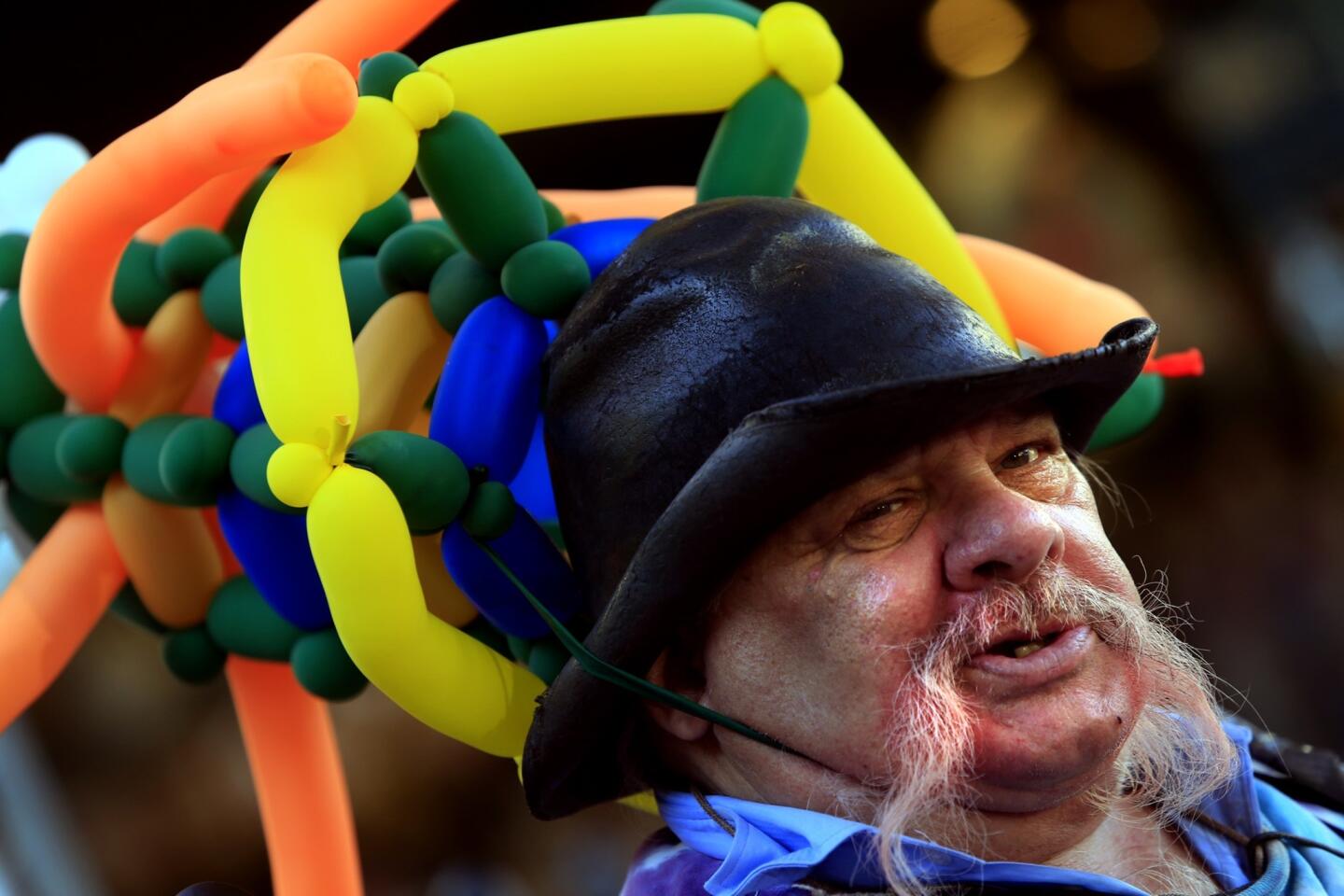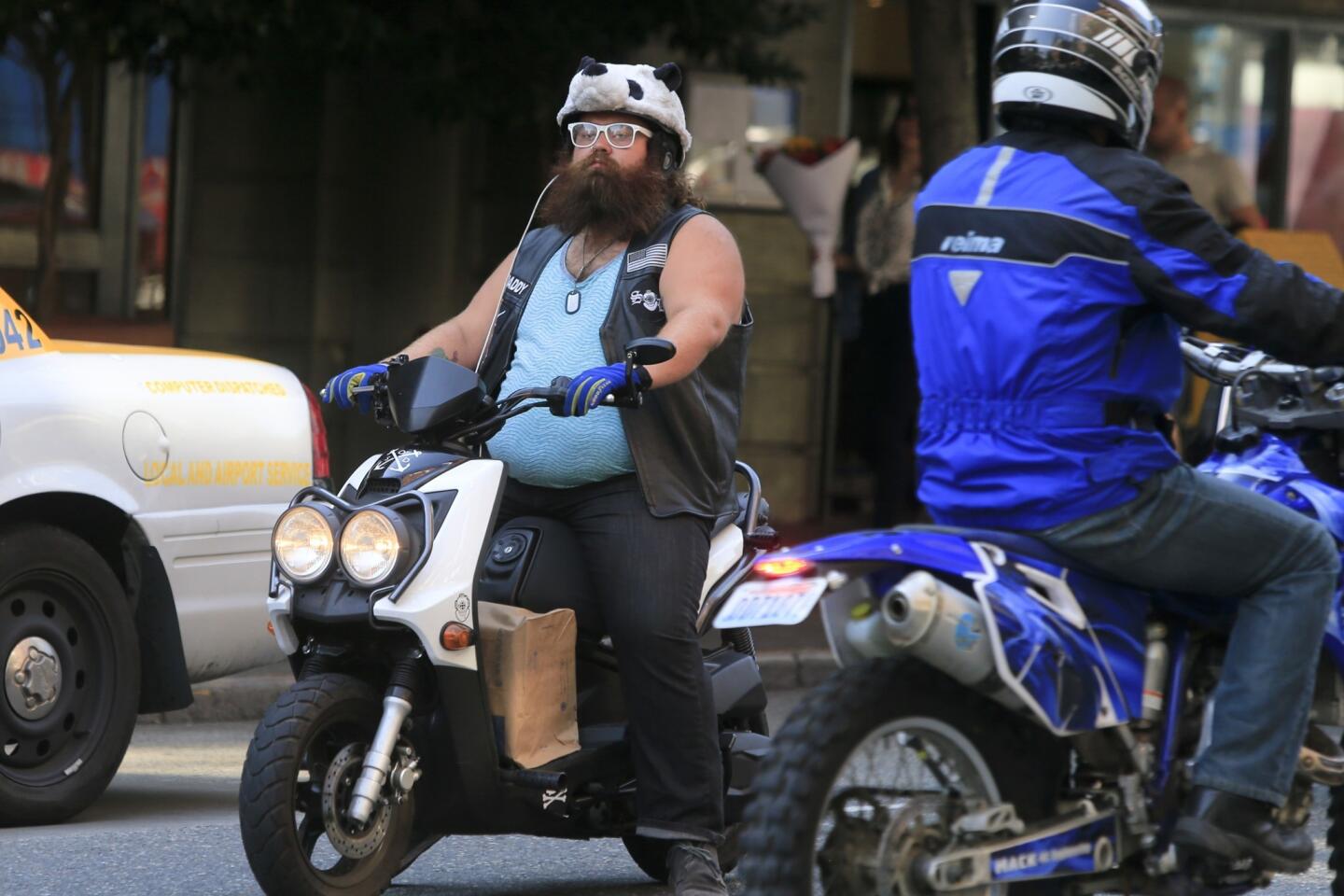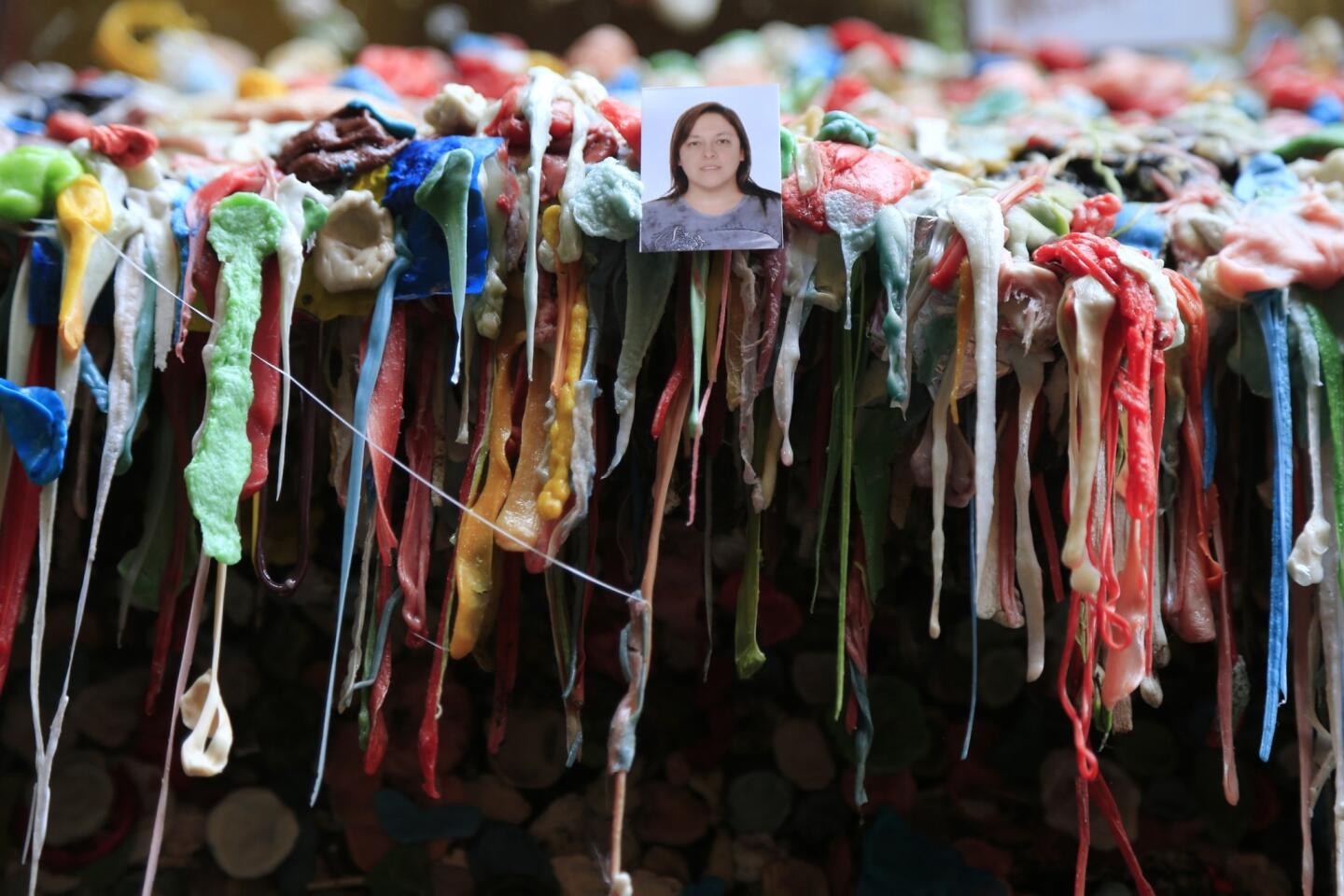Postcards From the West: Pike Place Market is a magical lure on Seattle’s bustling waterfront

The nine-acre market district features a rotating cast that includes farmers, artisans and fish merchants. It also has a senior center, food bank and child-care facilities.
- Share via
Reporting from Seattle — Somehow, on four visits to Pike Place Market over three decades, I failed to learn where the brothel was. Nor did I hear how the first Starbucks did business for years in this neighborhood before selling its first cup of coffee.
Clearly, I was missing a lot.
Like millions of tourists every year who approach this hillside warren of shops, stalls and eateries, I charged around sniffing flowers, appraising fish, listening to buskers, tasting produce, glancing at Elliott Bay or the Olympic Mountains and savoring the vintage magazine ads in Old Seattle Paperworks (“More doctors smoke Camels than any other cigarette!”). It was a sensory riot, and that was enough.
My fifth trip was different. In late August, Times photographer Mark Boster and I spent four days in the market, and this time I met more people and heard more history and backstage chatter.
First, the Pike Place Market Historic District is 9 acres — bigger than you thought, right? Besides its many stalls, which house a rotating cast of farmers (about 80) and artisans (about 225), its 20 buildings hold more than 30 restaurants and 250 stores, four fish merchants, a senior center, a health clinic, a food bank and a child-care center. (That child-care center, market officials say, is one reason weed will not be part of the market’s offerings any time soon, despite Washington state’s vote to legalize marijuana in 2012.)
Most visitors “never see it for what it is,” said Mercedes Carrabba, a second-generation market vendor who runs Ghost Alley Espresso and leads tours. It’s a city within a city, she said.
Carrabba likes to point out that more than 400 people live in the market district, that its first mortuary is now occupied by an Irish pub (Kells) and that Princess Angeline, daughter of Chief Seattle, lived in a shack on this hillside until her death in 1896.
The old brothel, Carrabba reports, did business in the LaSalle Hotel in the 1940s and ‘50s when madam Nellie Curtis handed out business cards reading, “Friends made easily.” It’s a residence for seniors now, just upstairs from the market.
If you’re a visitor, one obvious place to start is on the eastern side of Pike Place, where you can find the neighborhood’s biggest commercial success stories.
One is the first Sur La Table cookware store, opened in 1972. (By the way, you can’t see it from inside the shop, but just upstairs there’s a jaw-dropping 1,400-square-foot loft apartment. For $1,500 a night, it’s yours. For details, consult the front desk at the Inn at the Market next door.)
The even bigger story is Starbucks, which was born a block away in 1971 as a purveyor of coffee beans and equipment and moved to its current district spot in 1976. Management finally got around to selling coffee by the cup in the ‘80s. Also, at some point on the road to global domination, the company redrew its logo to make the mermaid more demure. But the Pike Place location still uses the topless original.
There are plenty of young businesses in the market too. Not far from Starbucks and Sur La Table is Steelhead Diner (opened in 2007), a sleek lunch and dinner destination that shows off its Black Witches and Green Butt Skunks (fishing lures, not cocktails) in museum-style displays. Just downstairs, Rachel’s Ginger Beer (opened 2013) brags about its Moscow Mules and Porch Swings (cocktails, not fishing lures). Radiator Whiskey, an upstairs den for dinner and spirits (not necessarily in that order), has done gangbusters business since opening last year.
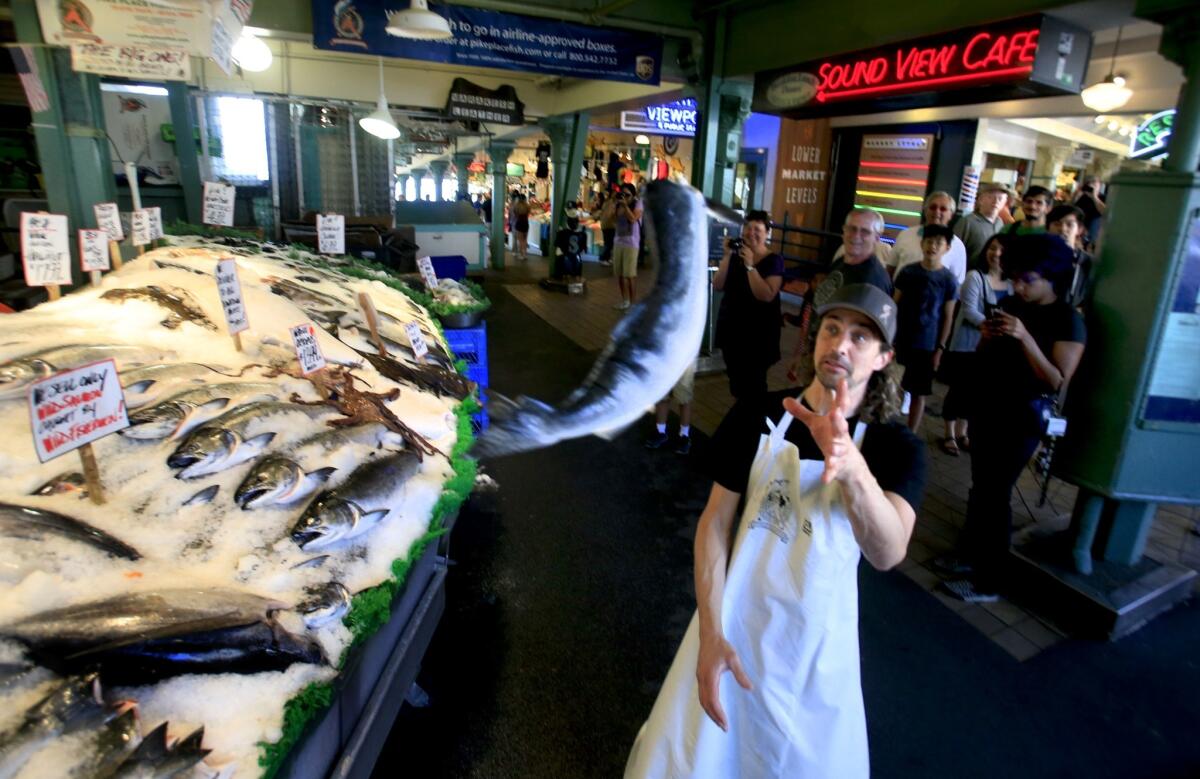
And, of course, you’ll need to linger at Pike Place Fish Market, where wisecracking mongers draw crowds with their hardy fish-flinging and order-hollering. John Yokoyama, its owner of 49 years, has a healthy side business in motivational books and speeches, and his guys speak that language too.
“If you’re short with people and you don’t love them, they’re going to go down the hall and spend their money,” fishmonger Jake Jarvis told me. “If we’re really having fun, people feel it.”
When I asked to buy a copy of Yokoyama’s and Joseph Michelli’s book, “When Fish Fly,” Jardin leaned back and hollered to all the world: “One Johnny book!” Then the mongers swarmed and seven of them signed the title page.
Some locals grumble that the market has become too touristy, especially when the cruise crowds shuffle through in summer. But I didn’t hear visitors complaining. Most seemed busy basking in the market magic.
Which isn’t magic at all, of course. It’s highly curated capitalism. To change the color of a fixture or stock a new product, tenants often need permission. Street performers annually renew permits to circulate among 13 designated spots (look for the musical notes painted on the pavement). To ensure turnover, the limit is one hour in a spot.
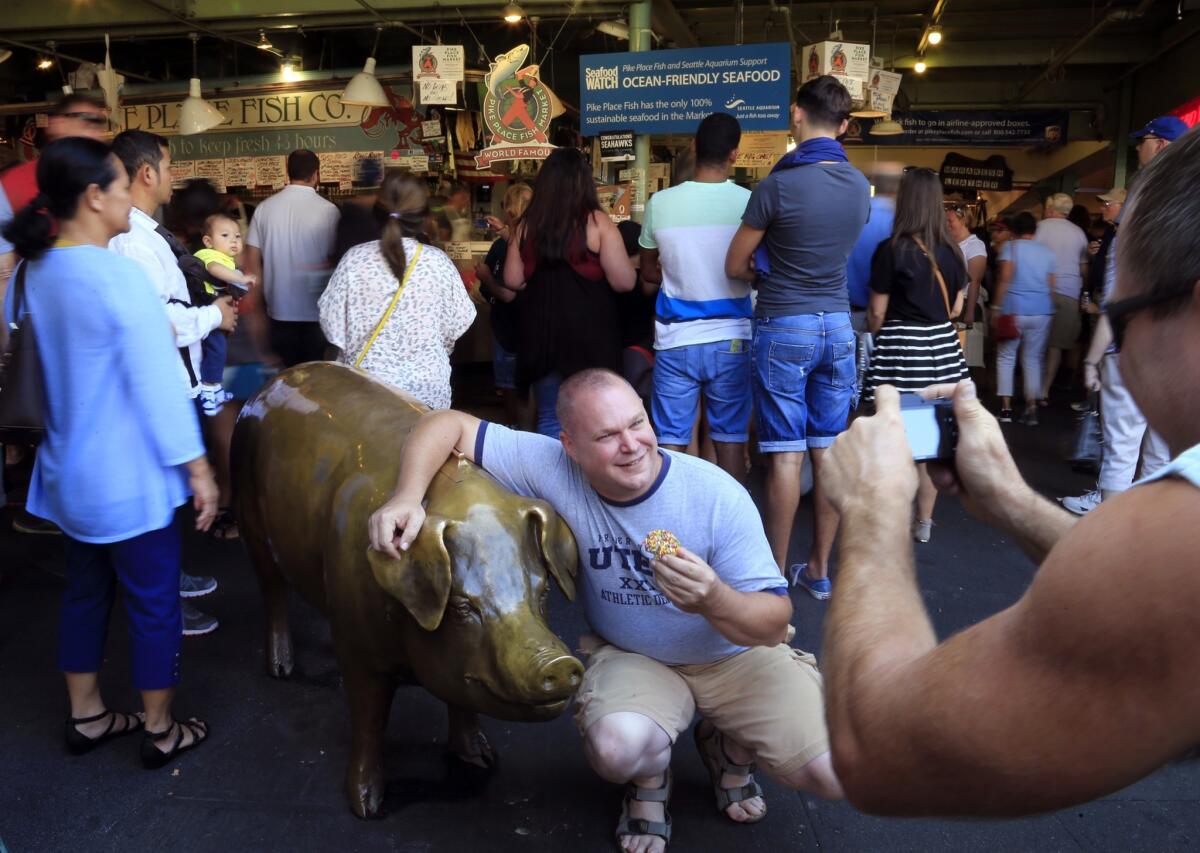
In fact, Pike Place’s birth and rebirth were both cases of government intervention in the marketplace.
In 1907, Seattle first set aside a patch of Pike Place as a farmers market because consumers were complaining that middlemen were inflating the price of onions and other produce. Once direct-to-the-public sales began, developers rushed in to put up buildings.
By 1971, many shoppers had turned to the suburbs, and privately owned Pike Place buildings were starting to fall apart. That’s when a citizens campaign to stave off demolition led to voter approval of a rescue plan. City officials created the Pike Place Market Preservation and Development Authority to set rents, approve tenants, keep out nonnative chains and enforce a set of restrictions that has grown to 48 pages. These crowded aisles might be the most carefully managed chaos this side of professional wrestling.
Fortunately, that’s not what most people think when they step up under that big orange Public Market Center sign. If they’re like me, they think: Who wants to catch a flying fish on a cold day? Would it be wrong to follow my morning croissant and coffee from Le Panier with pastry and coffee from DeLaurenti? Should I buy a CD from that guy with the rolling piano? What will my wife do if I come home with a cigar-box guitar made by that guy in the arcade?
Meanwhile, the market’s management has launched plans for a new $65-million waterfront entrance and addition on Western Avenue. State officials are tearing down the Alaskan Way Viaduct, which for decades has screened the market from much of the waterfront.
At Virginia Street and 2nd Avenue, a new Palladian hotel, a 97-room boutique property from the Kimpton chain, is scheduled to open late this year. At Stewart Street and 1st Avenue, a 159-room Thompson Hotel is to open in 2016.
In other words, more tourists are coming. Now all the market has to do is keep making magic.
____
Pike Place Market time line
1850s
City of Seattle is founded on Puget Sound.
1907
With consumers howling over a spike in the price of farm goods, Seattle officials earmark Pike Place, a newly planked street near the waterfront, as a spot for farmers to bypass middlemen and sell to the public.
1907
Rushing to capitalize on public demand, developer Frank Goodwin constructs and opens a building next to Pike Place with 76 produce stalls. Over the next few years, the city adds facilities, and private developers put up several rival market buildings clustered around Pike Place.
1922
European and Asian immigrant farmers fill many of the stalls; in fact, most of the farm vendors are Japanese Americans. City Fish, the market’s first fishmonger, opens shop.
1926
Some 627 farmers sell at the market, drawing 25,000 shoppers on a typical weekday. A 1927 city directory shows seven delicatessens, eight fish dealers, five florists, 31 meat markets and six tea and coffee dealers.
1928
Two dramatic neon Public Market signs, one of them with a clock, are added.
1930s
Despite the Depression, the market thrives, with 40,000 to 50,000 visitors on some Saturdays.
1942
After Japan’s attack on Pearl Harbor on Dec. 7, 1941, the U.S. orders Japanese Americans into internment camps, including more than half of Pike Place’s farm vendors. More than a third will never return to Seattle. Upstairs in the market complex, a madam named Nellie Curtis establishes the LaSalle Hotel as a bordello that will last into the early 1950s.
1940s and ‘50s
As supermarkets and suburbs grow, the market fades. By 1949, just 53 farmers hold permits to sell at the market.
1963
An urban renewal plan calls for demolition of the market area. The mayor and both major local newspapers support it, but a preservation campaign led by the Friends of the Market gains momentum.
1971
Starbucks opens at Western Avenue and Pike Place, offering whole beans and coffee-making equipment. In 1976, it moves to 1912 Pike Place, where it eventually starts selling cups of coffee.
1971
Seattle voters approve creation of Pike Place Historic District and a public agency to preserve its buildings and character. The city buys 14 buildings.
1974
The market, now managed by the nonprofit Pike Place Market Preservation and Development Authority, begins a decade of upgrades, including construction of five buildings. Spending on improvements amounts to $135 million, including $75 million in private investment.
1986
Rachel, a bronze pig (and charity piggy bank), is unveiled in the center of the market and becomes its leading photo opportunity.
2013
The state starts construction of a tunnel and surface streets to replace the Alaskan Way Viaduct (Washington 99), the double-deck highway that looms between Pike Place Market and Puget Sound. Completion target is 2016.
Sources: Pike Place Market Preservation and Development Authority, pikeplacemarket.org/history; city of Seattle registration form for National Register of Historic Places, bit.ly/1x3AjOa; Washington State Department of Transportation, 1.usa.gov/1mVJa3U
____
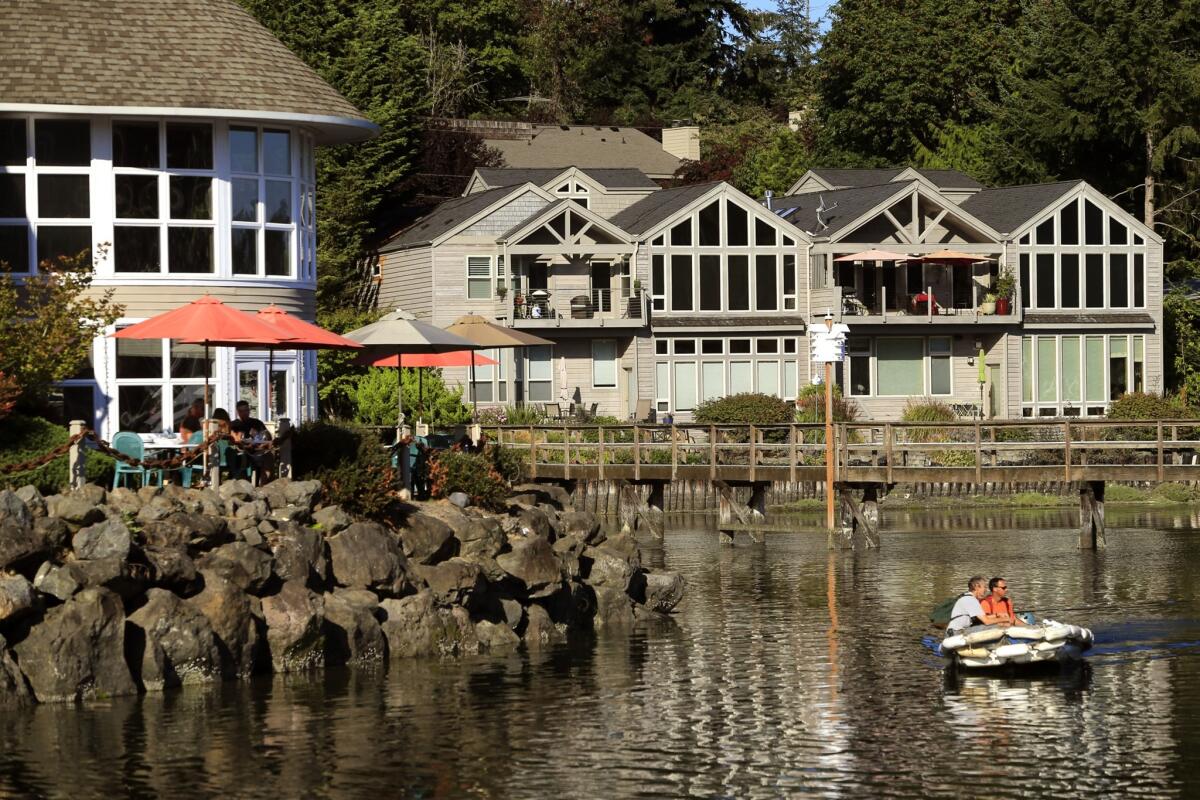
Bainbridge Island: Eat your way along, then walk it off
The Seattle waterfront wants you. Especially the Seattle Aquarium (Pier 59) and the Seattle Great Wheel (Pier 57), whose bright lights can be seen for miles. But if you’re there when the weather is mild, you might want to consider Pier 52, the ferry terminal.
That’s where you can catch a 35-minute ride to Bainbridge Island. The round-trip tab is just $8 a person, or $13.65 per car. (For adults, that’s way less than a $21.95 aquarium ticket or a $13 wheel ticket.) The trip will take you far from the urban grid.
The island (population 23,196) is close enough for islanders to commute to Seattle on the ferry yet far enough away to feel like another country. I gave it only about four hours — a serious tactical error because I could have spent five hours just eating, never mind the 30 miles of trails (bit.ly/1yzyBc0) or the seven wineries (www.bainbridgewineries.com).
Once the ferry has pulled into Eagle Harbor, it’s an easy walk up (perhaps a quarter of a mile) Olympic Drive Southeast to Winslow Way East, the main drag of the tiny town of Winslow.
There the diversions begin with the curvy Bainbridge Island Museum of Art (550 Winslow Way E.; [206] 842-4451, biartmuseum.org), which opened in June 2013 and specializes in contemporary works with a regional focus. Then come the restaurants and shops.
I got a snack at Blackbird Bakery (210 Winslow Way E.; [206] 780-1322, blackbirdbakery.com), which has been serving baked goods, soups, quiche and such since 1999. I bought a hat at Back of Beyond (181 Winslow Way E.; [206] 842-9229, tothebackofbeyond.com), which also rents kayaks and canoes.
I prowled the waterfront trail at the foot of Madison Avenue, browsed Eagle Harbor Book Co. and Bainbridge Arts & Crafts, then settled in for late lunch at Doc’s Marina Grill (403 Madison Ave. S.; [206] 842-8339, www.docsgrill.com), a casual, surfy-turfy place with a big patio overlooking the marina. (Most main dishes $12-$26.) And I eavesdropped on two grade-school girls as they passed me on the sidewalk and glanced up at the bell tower of a white clapboard church.
“That’s a Congregational church,” the older girl said. “I have no idea what they do in there.”
Then came a difficult choice: a drink at Hitchcock (133 Winslow Way E.; [206] 201-3789, hitchcockrestaurant.com), a locavore restaurant and bar that opened in 2011, or dessert at Mora Iced Creamery (139 Madrone Lane; [206] 855-1112, moraicecream.com), part of a three-location Seattle-area chain. Mora’s blackberry gelato (made from local berries) won me over. But next time it’ll be dinner at Hitchcock, whose chef, Brendan McGill, has won a kitchen full of best-chef prizes.
I wouldn’t make any changes in the timing of my return trip, though. If you catch the ferry just before dark, as I did, you can watch the sun set as the island fades into the distance and the Seattle skyline begins to light up. That’s $8 well spent.
____
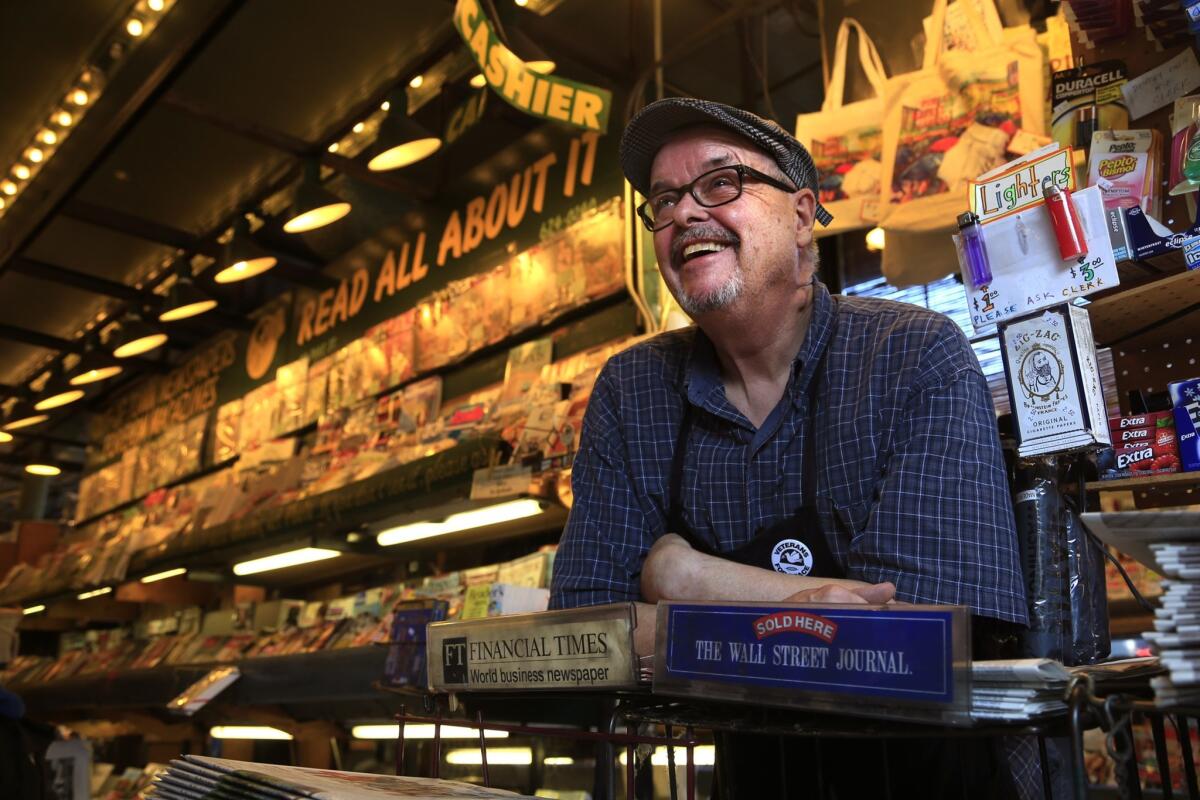
Read all about it at Pike Place Market’s First & Pike News
Lee Lauckhart works a busy corner of Pike Place Market, peddling newspapers and magazines, giving tourists directions, savoring the rituals of life on the sidewalk.
He’s done this for 35 years, and the numbers say he should probably stop. But he’s not ready.
“My mother always said I had printer’s ink in my blood, because we had so many newspaper owners and writers in the family,” Lauckhart says. “But nobody had stooped so low as to sell the newspapers.”
Then came Lauckhart. His degree from the University of Washington is in public health. But when he was 35, a brother-in-law on the East Coast offered him a temporary gig running a newsstand at 23rd and Park Avenue in Manhattan. It was cold, and it was the early ‘70s — miserable years in New York, by many measures. But “I just liked the whole action thing. I’d never even made change.”
When Lauckhart returned to Seattle, he sold jewelry at the northern end of the market, then joined a partner and opened a newsstand on Pike Place, which was resurgent in the late 1970s. Later, he bought out the partner. It’s called First & Pike News, though old-timers still use its previous name, Read All About It.
He remembers when there were few flower merchants, when most fishmongers were Sephardic Jews, when Starbucks was selling beans and equipment, not cups of coffee.
His best year? 1994. Nine employees then. There are four now, as the newspaper business withers and magazines fade.
But Lauckhart, a canny 72-year-old with a plaid cap and a Financial Times apron, can’t help himself. This is what he loves — the foreign titles, the ebb and flow of locals and tourists shouldering their way toward the flying fish or the Hmong flower merchants. The regulars grunt greetings as they reach for the Yiddish Forward, Cemetery Dance magazine or the Nome Nugget. He has 2,345 titles in about 350 square feet, he says, but “for the last four or five years, I haven’t been making any money at all on this.”
What keeps him afloat is other stuff tourists want: postcards, stamps, ChapStick, batteries, aspirin and such. Also refrigerator magnets, for which, believe it or not, he needed the landlord’s permission.
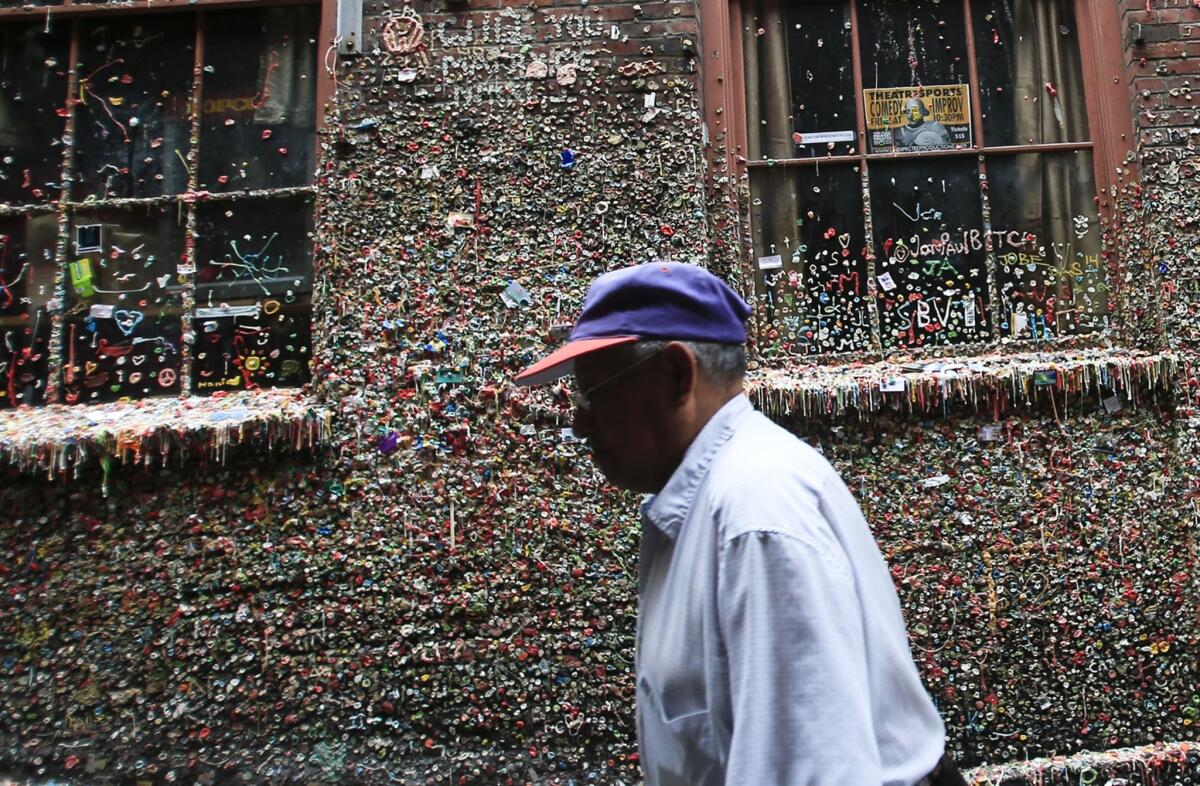
The most common tourist question? They want to know the way to the Gum Wall, a gooey, rainbow-hued landmark that’s just what it sounds like. It’s next to the Market Theater about 100 feet from Lauckhart’s news racks.
“People come here 40 times a day asking for it,” he says. “It’s the most disgusting, ridiculous public attraction ever.”
Yet once they see it, tourists want to contribute to the wall themselves. And the nearest place to buy gum is — well, the newsstand. A small smile plays on Lauckhart’s face.
“I sell a lot of gum,” he confesses. “About half the gum down there came from me.”
____

Do’s and don’ts when visiting Seattle’s Pike Place Market Historic District
The Pike Place Market Historic District (85 Pike Place; [206] 682-7453, pikeplacemarket.org) covers 9 acres and includes more than 200 vendors. The heart of the place for most tourists is just beneath the big orange Public Market Center sign and clock. Do pose for a photo with Rachel, the bronze charity piggy bank. Keep an eye out for flying fish (Pike Place Fish Market is a short toss away) and listen for music; buskers love this spot.
— Don’t rent a car to get around downtown Seattle. Since 2009, Sound Transit’s Central Link light-rail system (www.soundtransit.org) has run trains from the SeaTac Airport to the underground Westlake Station at 4th Avenue and Pine Street, about four blocks from Pike Place. It’s a 35-minute trip. Trains leave every seven to 15 minutes, $2.75 each way. Info: bit.ly/1rEjdWS
— Don’t go looking for night life at the market. Though a few restaurants have busy bars (Pink Door and Radiator Whiskey, for instance), most of the market area is idle by 10 p.m., and surrounding blocks can be sketchy.
— Don’t expect pristine solitude in Victor Steinbrueck Park (2001 Western Ave.) at the north end of the market. The views and totem poles are impressive, but crowds are often thick and panhandlers and dope dealers work the area hard.
Within 300 feet of the market clock
— Do spend a few minutes gawking at Pike Place Fish Market (86 Pike Place; [206] 682-7181, www.pikeplacefish.com), where fishmongers holler and fling their salmon, halibut and other goods.
— If you need some dead-tree reading — the latest Nome Nugget newspaper, for instance, or a European magazine — or a postcard or stamp, do stop at First & Pike News (93 Pike St., [206] 624-0140).
— If you’d like to see brick walls bedecked with recycled chewing gum (or you would like to see a show at the Market Theater, [206] 587-2414), do head to 1428 Post Alley, which is beneath the market proper and across the alley from the Alibi Room bar. The gum bits started to accumulate in the 1990s and got a big boost when National Geographic gave the site a two-page spread in June 2010.
— For Chinese food in a tight space with a big view, do consider Pike Place Chinese Cuisine (1533 Pike Place; [206] 223-0292, no website). Most main dishes up to $15.95.
— For a stylish dinner in a buzzing room, do try Steelhead Diner (95 Pine St.; [206] 625-0129, steelheaddiner.com), where the menu is heavy on seafood. Excellent chowder. Main dishes $18-$38.
— Do climb up to Matt’s in the Market (94 Pike St., No. 32; [206] 467-7909, mattsinthemarket.com) for a sophisticated meal and view of the market with Puget Sound behind it. Matt’s, which dates to 1996, is an elder statesman among upscale restaurants at the market. Dinner main dishes $28-$47.
— For a stiff drink (or half a smoked pig’s head, if you dare), do try Radiator Whiskey (94 Pike St., No. 30; [206] 467-4268, radiatorwhiskey.com), an atmospheric bar that opened in 2013 across from Matt’s in the Market. Besides spirits, this place offers a short dinner menu, with main dishes typically $13-$18. The half pig’s head, which feeds two to three, is $48.
— If you need to sober up, year-old Storyville Coffee (94 Pike St., No. 34; [206] 780-5777, www.storyville.com) is down the hall.
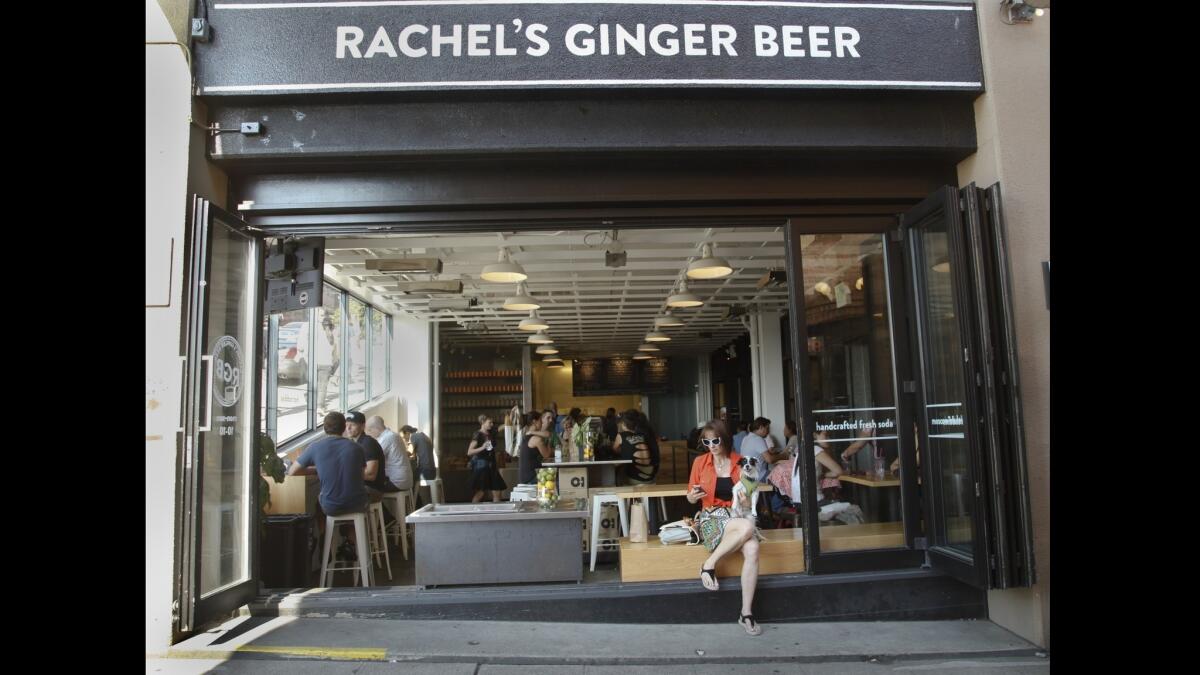
— To taste what the buzz is all about, do sample some of Rachel’s Ginger Beer (1530 Post Alley; [206] 467-4924, rachelsgingerbeer.com). Some people step up for a sweet refreshment, such as the blood orange ginger beer float with vanilla soft serve that I ordered. (Excellent, $8.) Others choose the $8 Montana Mule. Rachel’s isn’t cheap, but lines often stretch out the door.
— To understand where you really are (or to plan your next trip), do browse Metsker Maps (1511 1st Ave.; [206] 623-8747, www.metskers.com). Great shop for travelers, hikers and geo-nerds. Maps, globes, books.
— Don’t go looking for an early snack at De Laurenti Specialty Food & Wine (1435 1st Ave.; [206] 622-0141, delaurenti.com). This beloved source for Italian ingredients and snacks doesn’t open until 9 most mornings, 10 on Sundays. But the long table in front is a great spot for strong coffee and tasty raisin croissants.
— Do try Ghost Alley Espresso and Market Ghost Tours (1499 Post Alley; [206] 805-0195, www.ghostalleyespresso.com, www.seattleghost.com). Mercedes Carrabba converted a 147-square-foot closet into this snug caffeine haven and tour-guide headquarters. Coffee $1.75-$4.25. Besides spooky stuff, her tours feature plenty of legit history. Adults pay $16.50 for a 75-minute tour.
— Do have breakfast at Lowell’s (1519 Pike Place; [206] 622-2036, eatatlowells.com) and watch a ferry glide through the sound. Opens at 7 a.m. daily. “Almost classy since 1957,” the signs say. Also open for lunch and dinner. Dining areas on three levels, big views and cinnamon rolls almost as big. Dinner main dishes $13-$31; breakfast dishes $8-$21.
— If you’re young and pinching pennies, do explore the Green Tortoise Hostel (105 Pike St.; [206] 340-1222, www.greentortoise.com). It’s reasonably clean, with a prime location. Rates typically $30-$36 per bed per night; private rooms $78-$82. Shaggy travelers from many lands share dorm rooms (some single sex, some coed) with four to eight bunk beds. Breakfasts are free, as is dinner three nights a week.
— Do look for Soul Cat Guitars (www.soulcatguitar.com) among the market’s craft stalls. The cat in question is Dean Moller, a veteran woodworker and musician who makes guitars and ukuleles from colorful cigar boxes ($280-$695).
— If you need a quick bite and some prime people-watching, do dip into Sisters European Café (1530 Post Alley; [206] 623-6723, sisterseuropeancafe.com), which basks in hues of yellow and orange. Best observation seats are the counter stools facing the alley. Breakfast and lunch. Most sandwiches $6.95-$9.95.
Within 500 feet
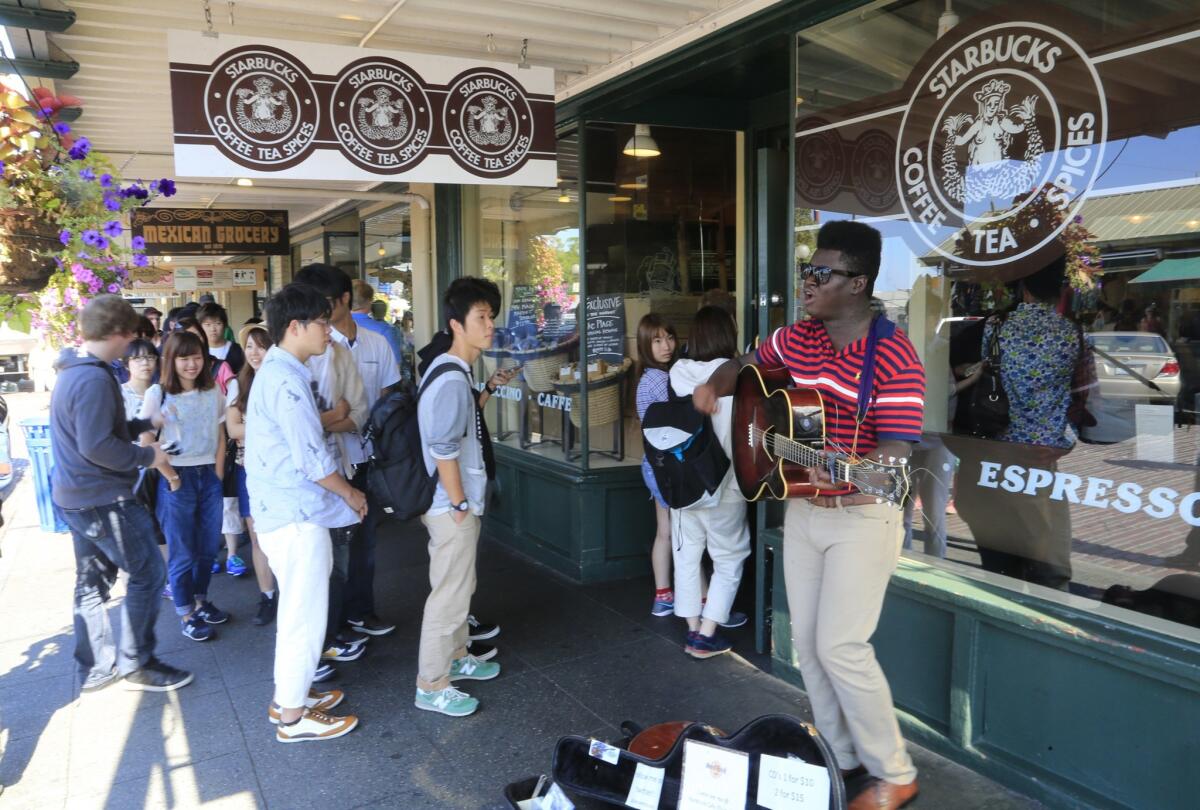
— Do try the first Starbucks (1912 Pike Place; [206] 448-8762, bit.ly/10lJOOf), which always seems to have buskers outside and a line of people buying merchandise. The first Starbucks opened a block away (building now gone) in 1971, then moved here in 1976.
— For a boutique-hotel lodging a few steps from the fresh produce, do check out the 75-room Inn at the Market (86 Pine St.; [206] 443-3600, innatthemarket.com), which has been at the market (in a purpose-built building) since 1985. Rooms for two are typically $199-$500. For an over-the-top evening, ask about renting the inn’s best unit. Beecher’s Loft (from $1,500 a night) is a 1,400-square-foot luxury apartment with a big kitchen, ample balcony and amazing views of the market and Puget Sound.
— For breakfast with a French accent, do try Le Panier Very French Bakery (1902 Pike Place; [206] 441-3669, www.lepanier.com), which opens at 7 a.m. and fills up fast. On the scene since 1983. Good people-watching, great raspberry croissants ($3.25).
0.1 mile
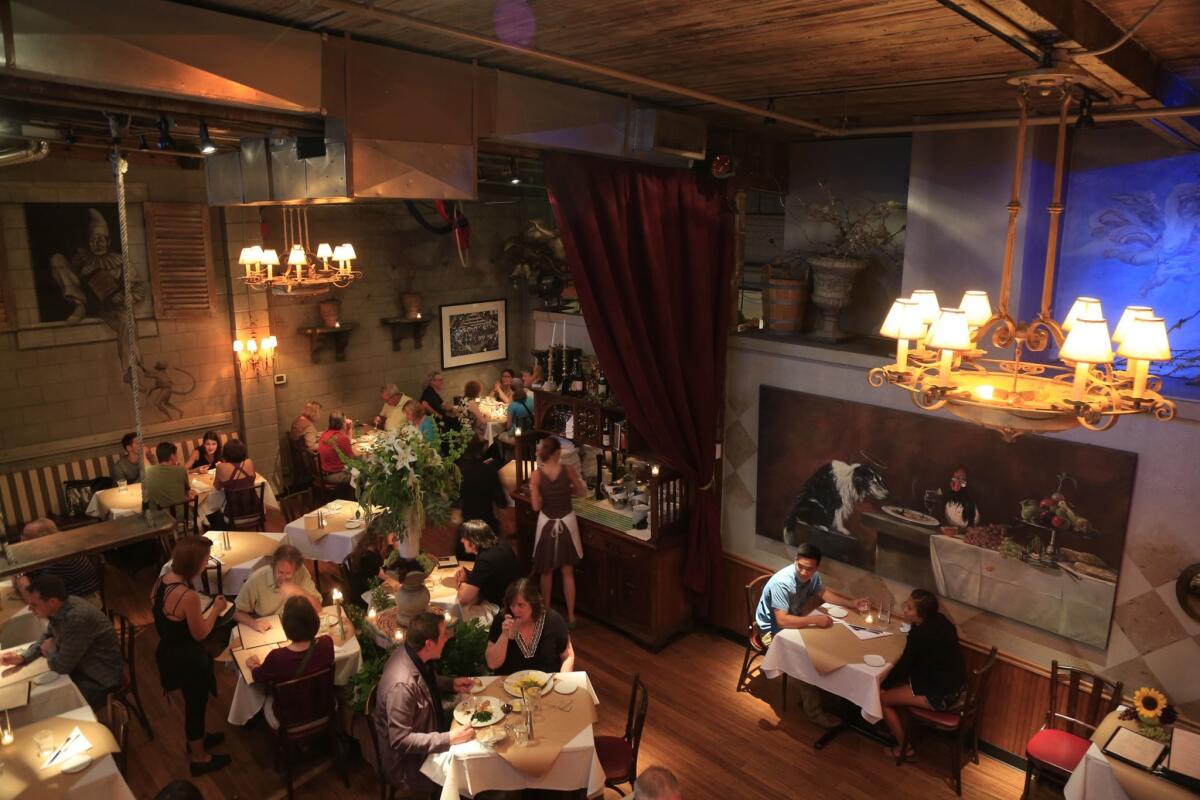
— For a romantic dinner, do head to the Pink Door (1919 Post Alley; [206] 443-3241, thepinkdoor.net), which dates to 1981. The menu is Italian. Enormous patio, frequent live music, and sometimes you’ll find a trapeze artist, in burlesque attire, hovering over indoor diners. (It’s a short act, but memorable.) Main dishes $17-$28.
— Even if it doesn’t rain, you do need to duck into the Seattle Art Museum (1300 1st Ave.; [206] 654-3100, seattleartmuseum.org). On view through Jan. 11: “Pop Departures,” featuring the works of icons such as Andy Warhol, Roy Lichtenstein, Robert Indiana and Claes Oldenburg.
0.2 mile
For offbeat, moderately priced lodging inside the market district, do investigate Pensione Nichols Bed & Breakfast (1923 1st Ave.; [206] 441-7125, pensionenichols.com). Eight guest rooms share three hall bathrooms. Rates typically $130-$180 a night; $230-$280 for two 900-square-foot apartments with private baths and full kitchens. The rooms and apartments are on the second and third floors of a historic building.
0.3 mile
For an affordable room, do consider the Moore Hotel (1926 2nd Ave.; [206] 448-4851, moorehotel.com), which dates to 1907. Parking is a sketchy block away. Tiny elevator. Halls have hostel overtones, but the hotel was recently upgraded and has a good coffeehouse next door. (Don’t miss the video “fireplace.”) Low rates two blocks from the market. Many rooms share hall bathrooms, fetching $72-$98 a night. Rooms with private baths $92-$118.
0.5 mile
For locavore thrills and modern American comfort food, do try Local 360 (2234 1st Ave.; [206] 441-9360, local360.org), a short walk from Pike Place on an increasingly upscale stretch of 1st Avenue. About 90% of its ingredients come from within 360 miles. Rough-wood booths, dish-towel napkins. Lunch dishes $8-$19; dinners $12-$28.
Twitter: @MrCSReynolds
More to Read
Sign up for The Wild
We’ll help you find the best places to hike, bike and run, as well as the perfect silent spots for meditation and yoga.
You may occasionally receive promotional content from the Los Angeles Times.
